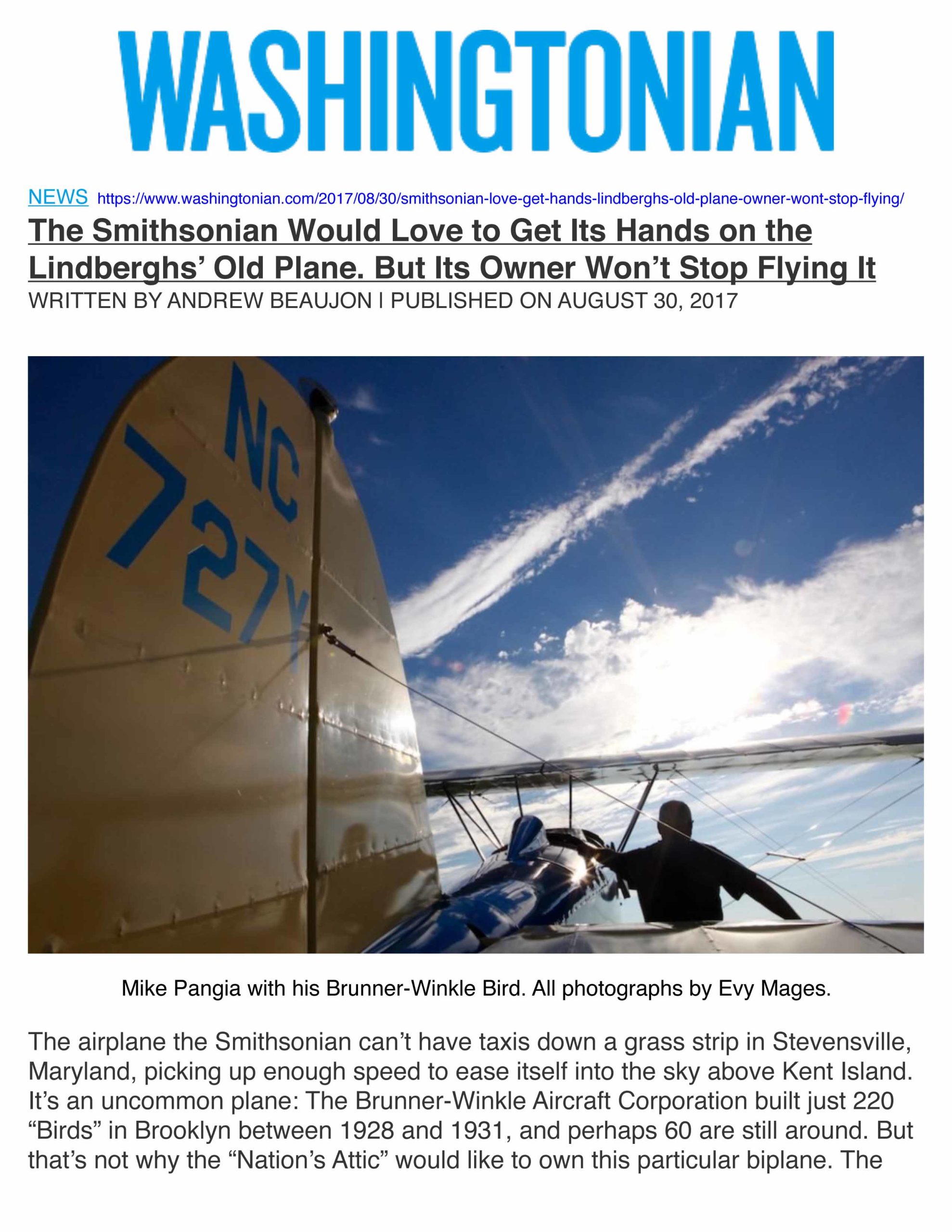

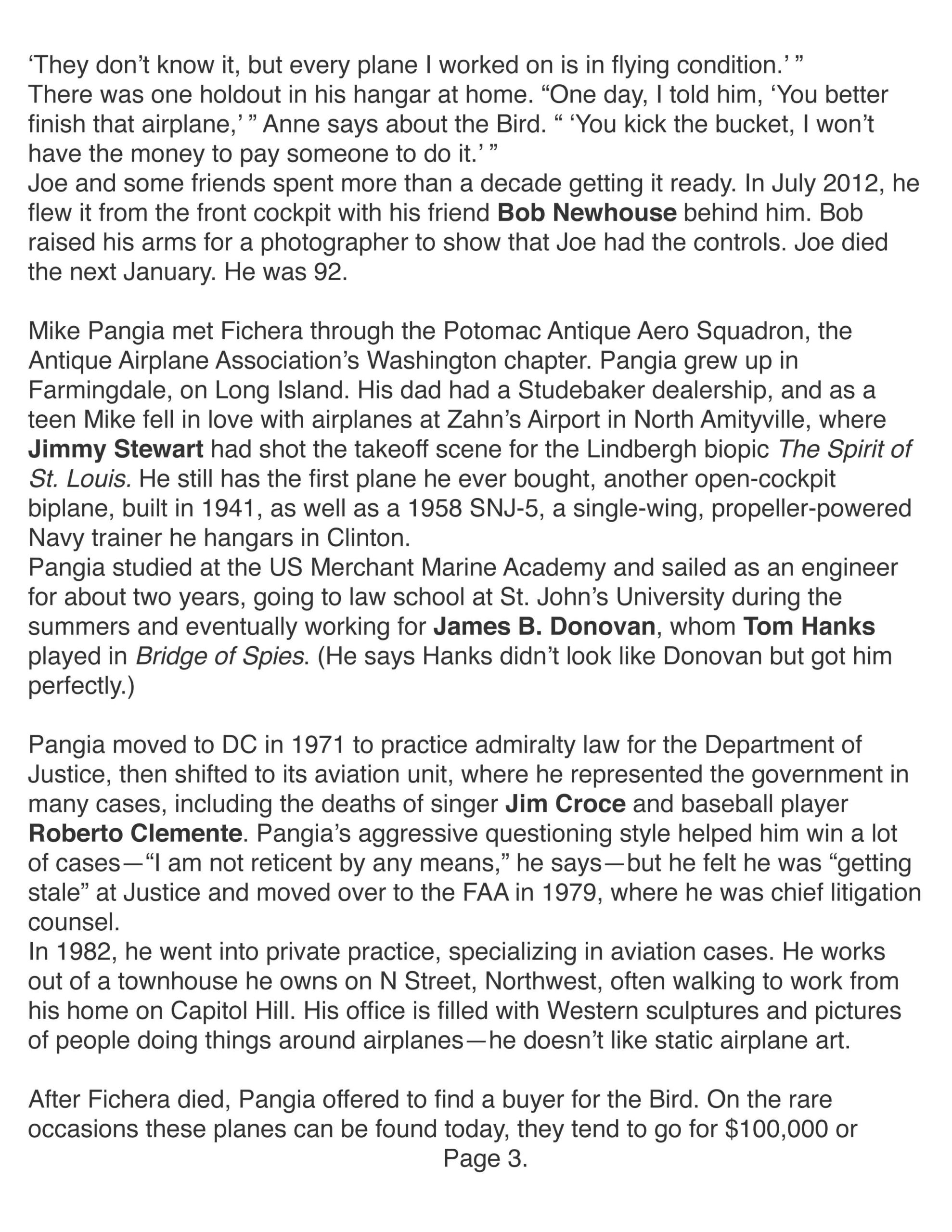
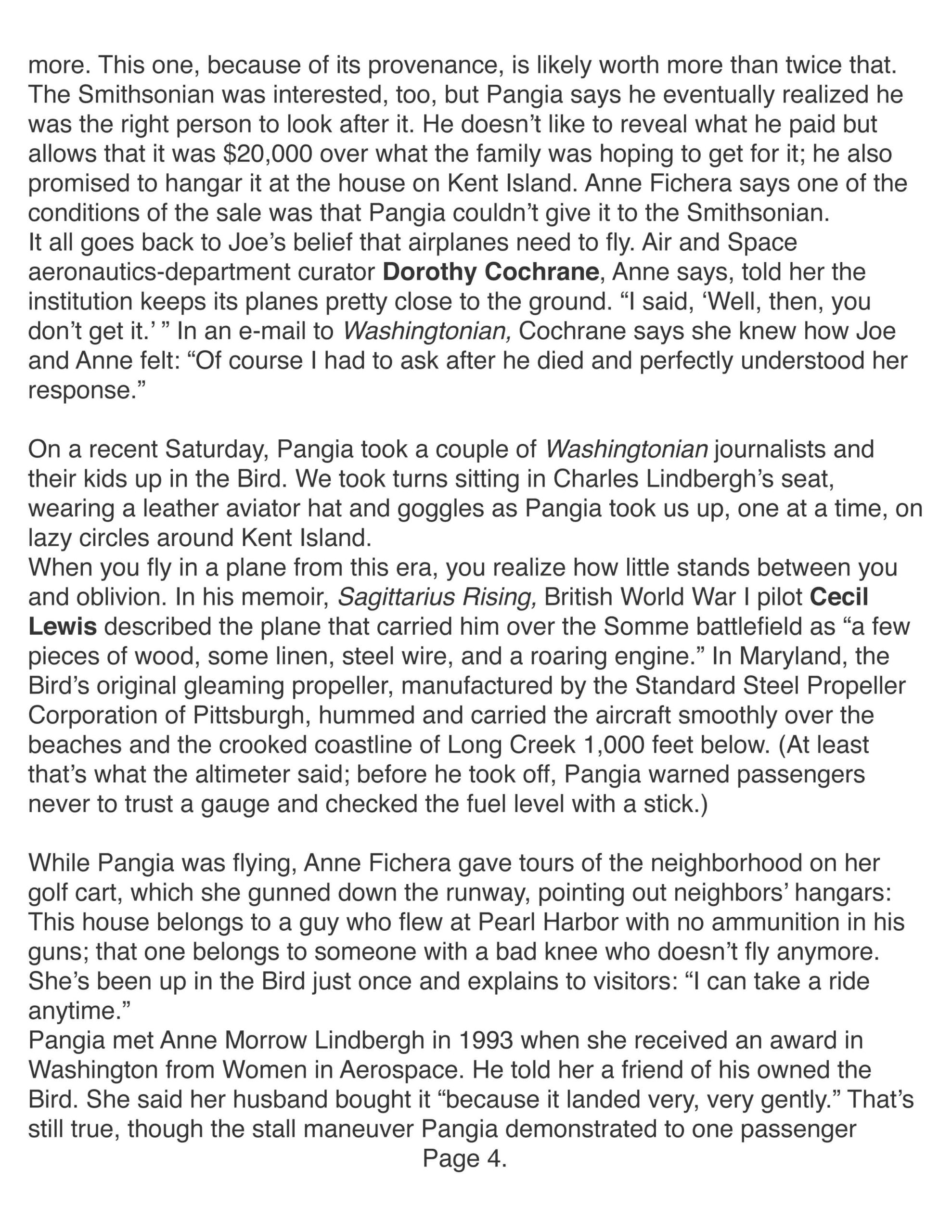
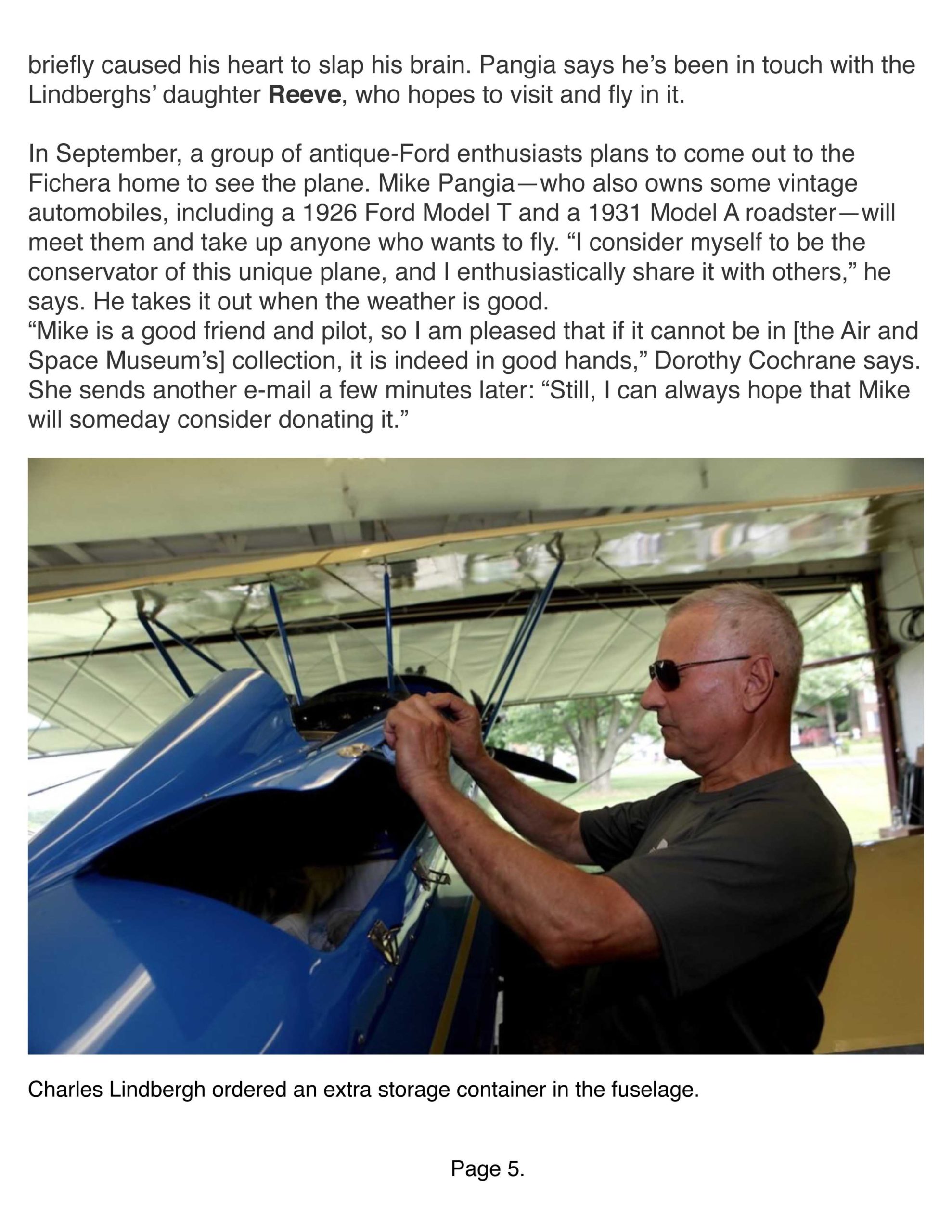
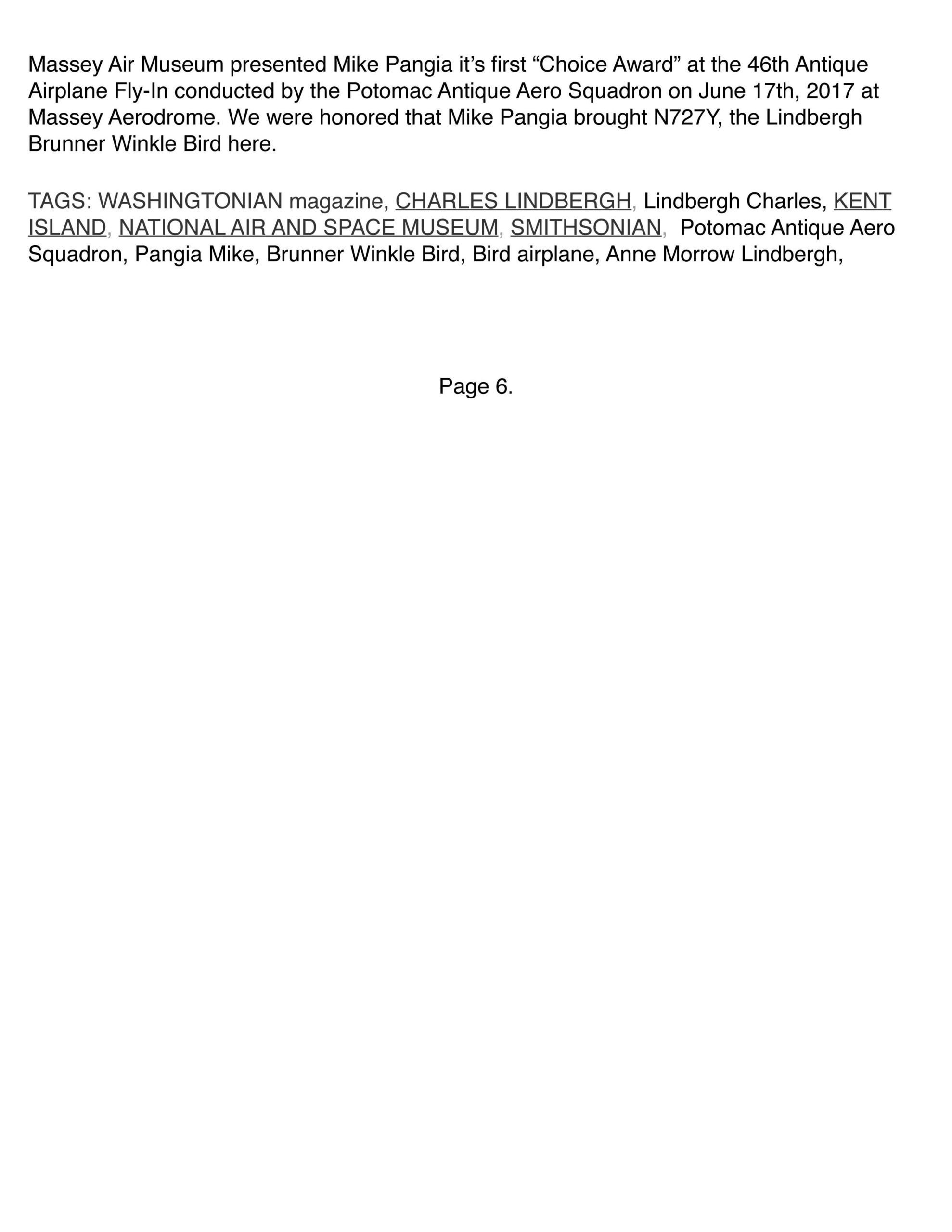
Author: William Dougherty
2021 Museum Chatter Newsletter (Jan. 2022)
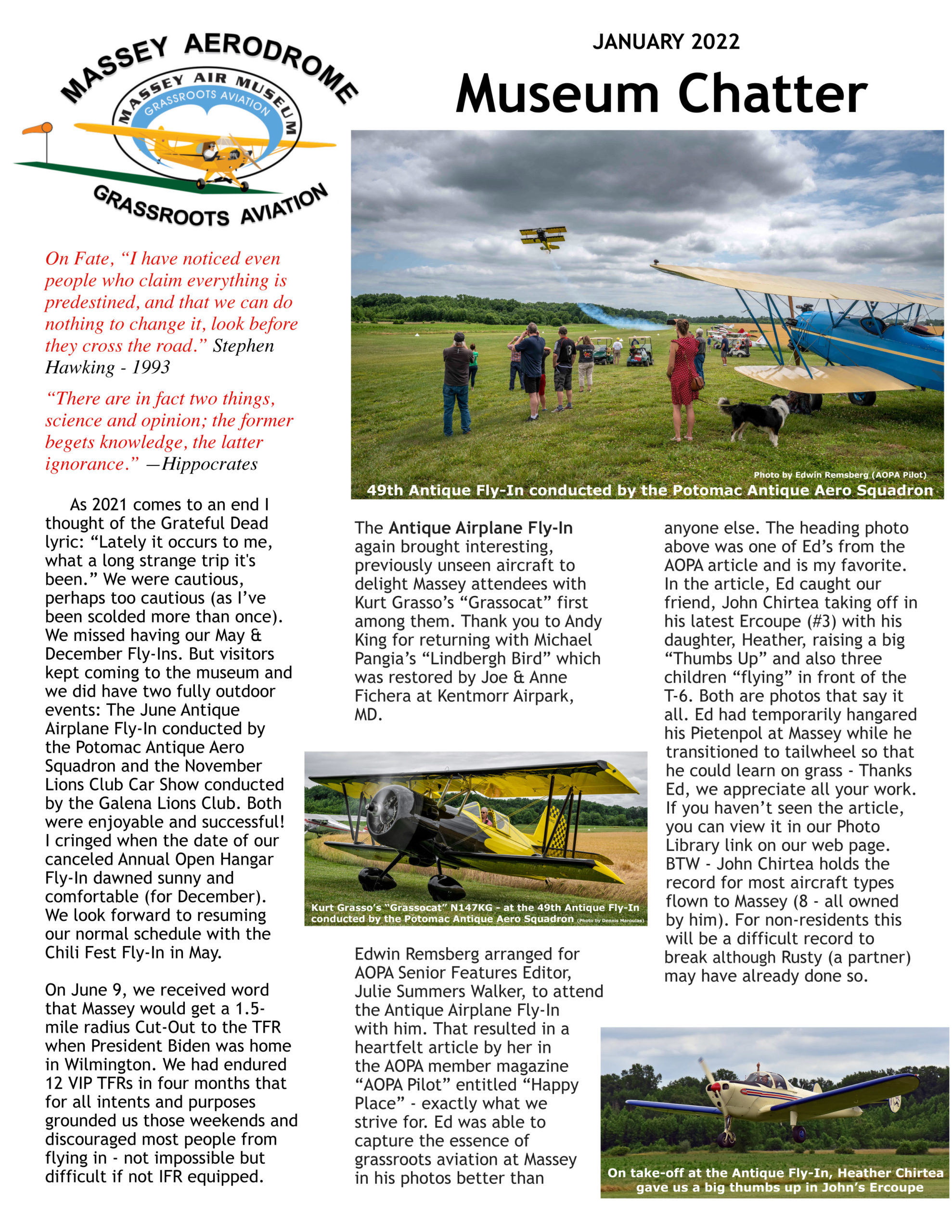 Page 1.
Page 1.
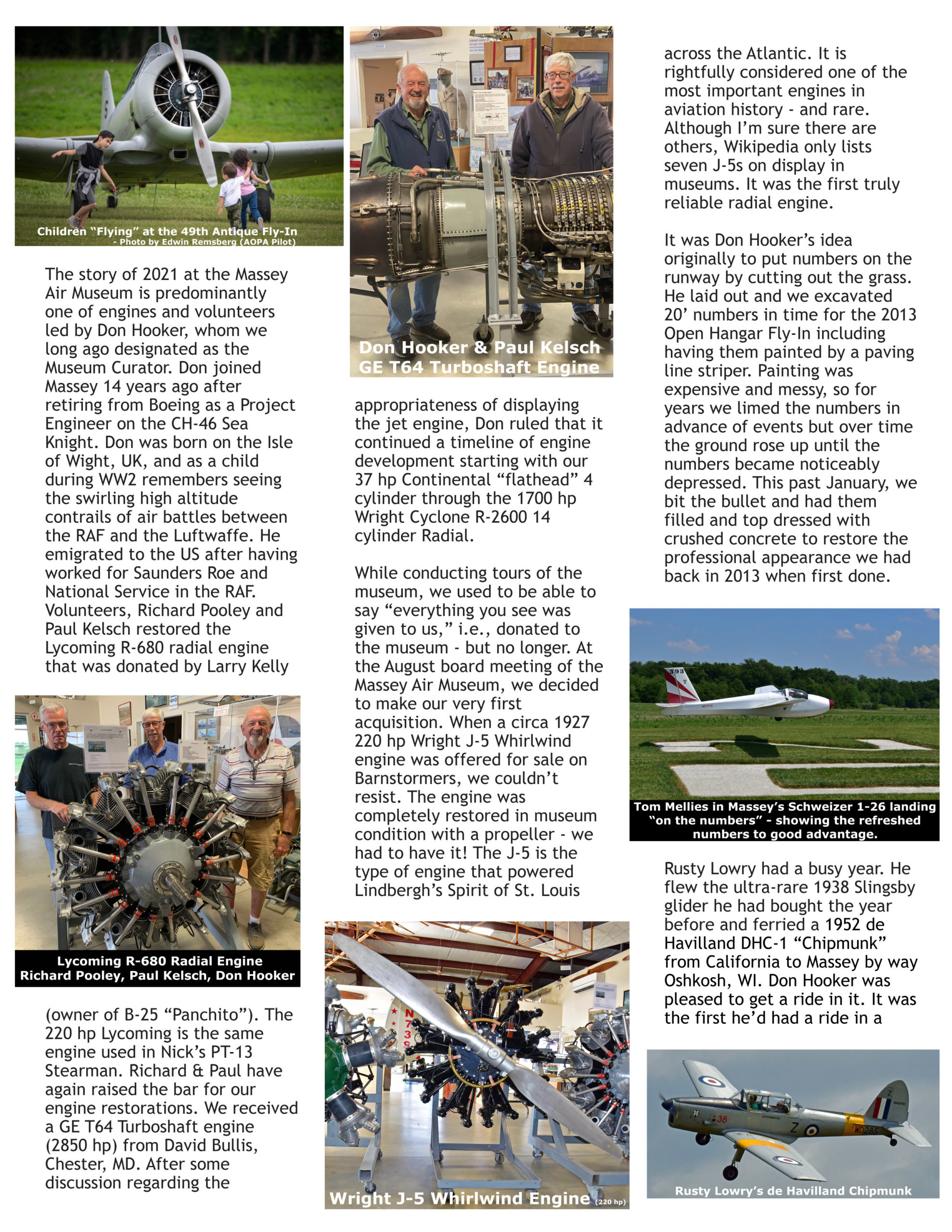
Page 2.
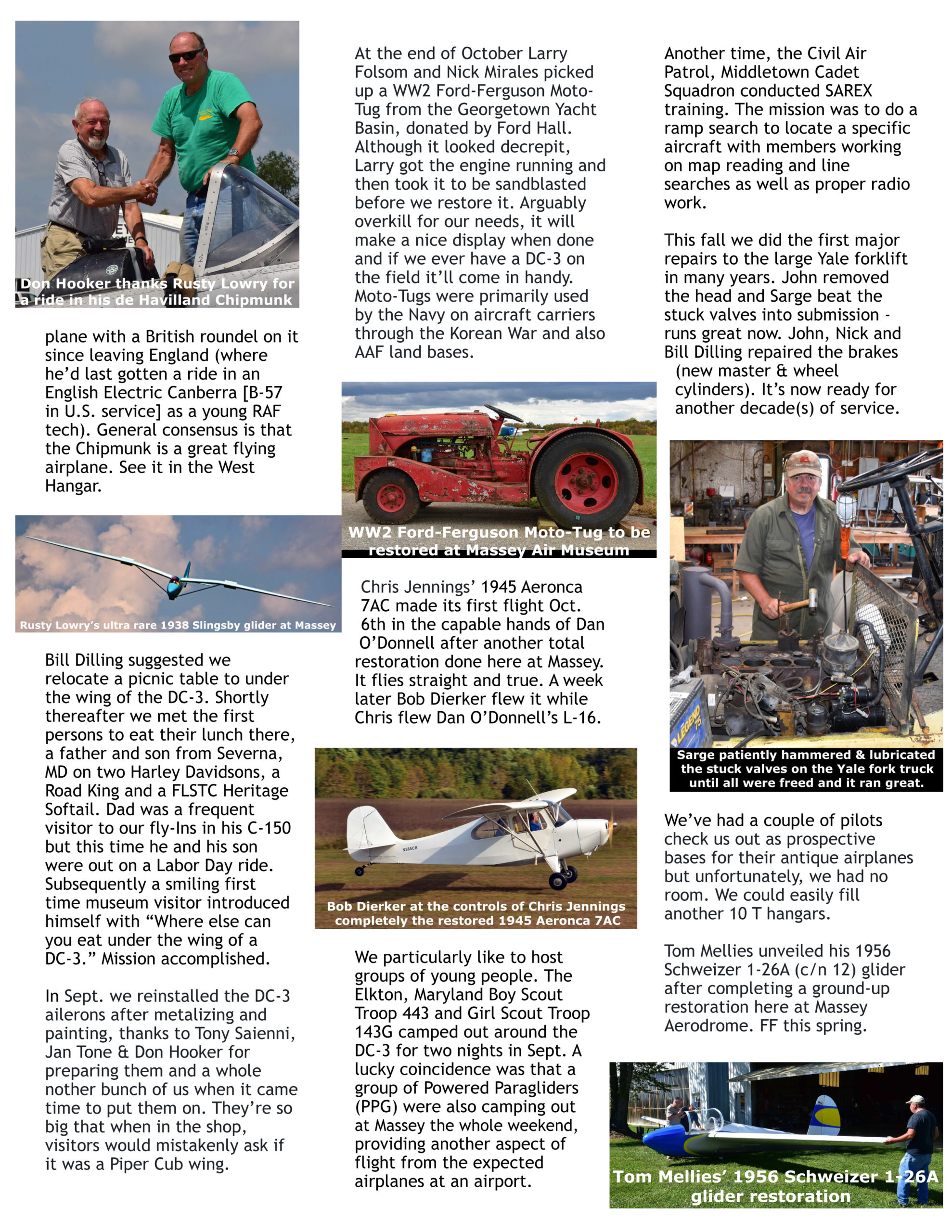
Page 3.
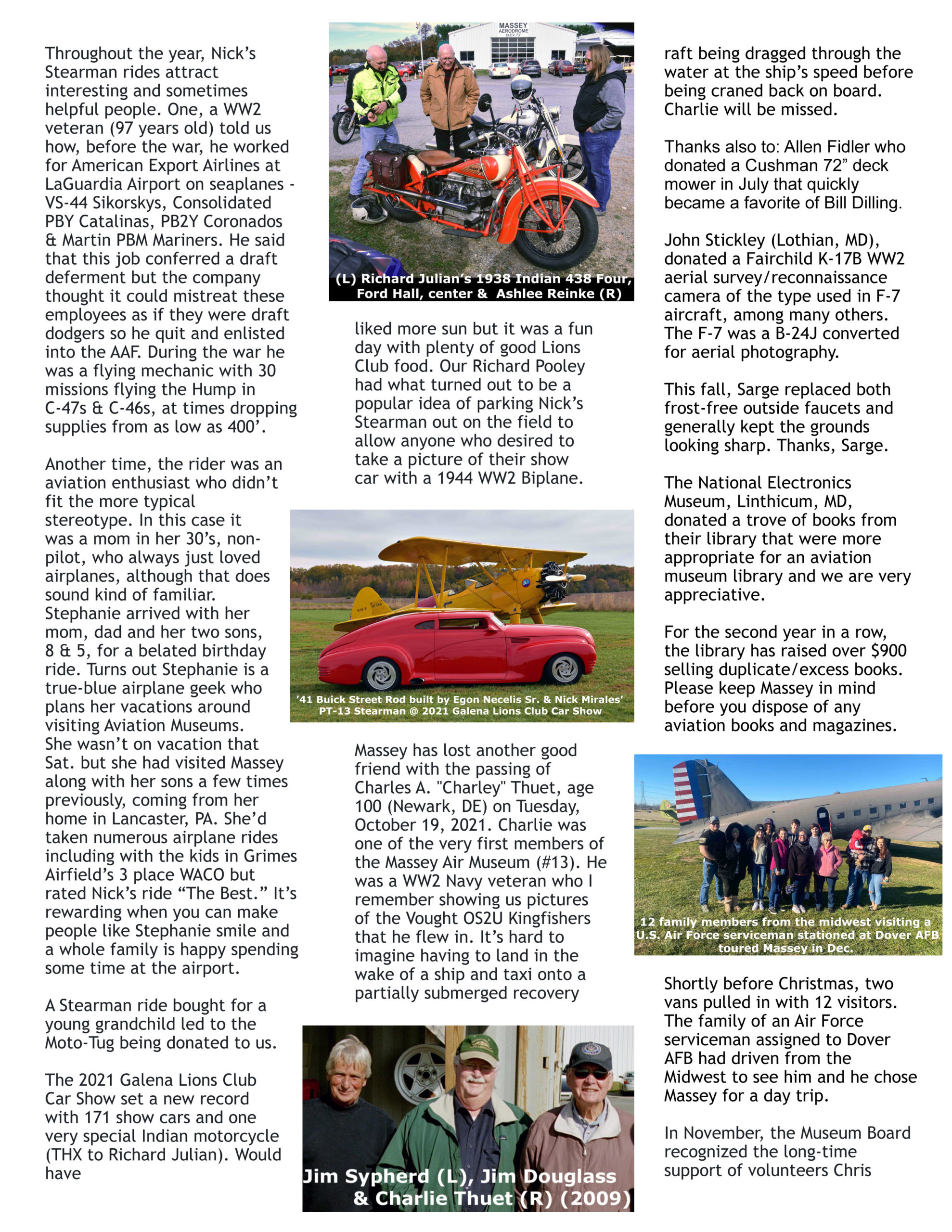
Page 4.
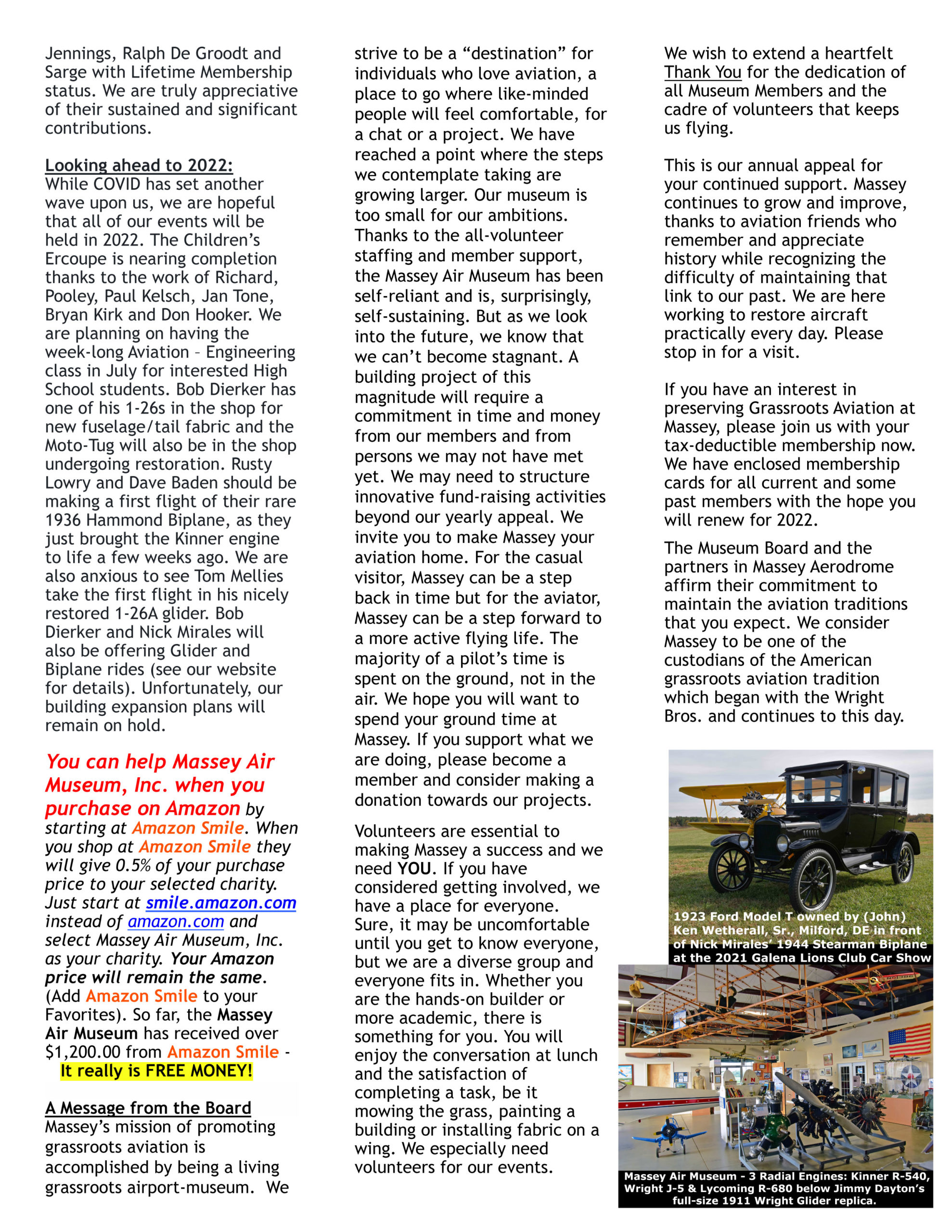
Page 5.
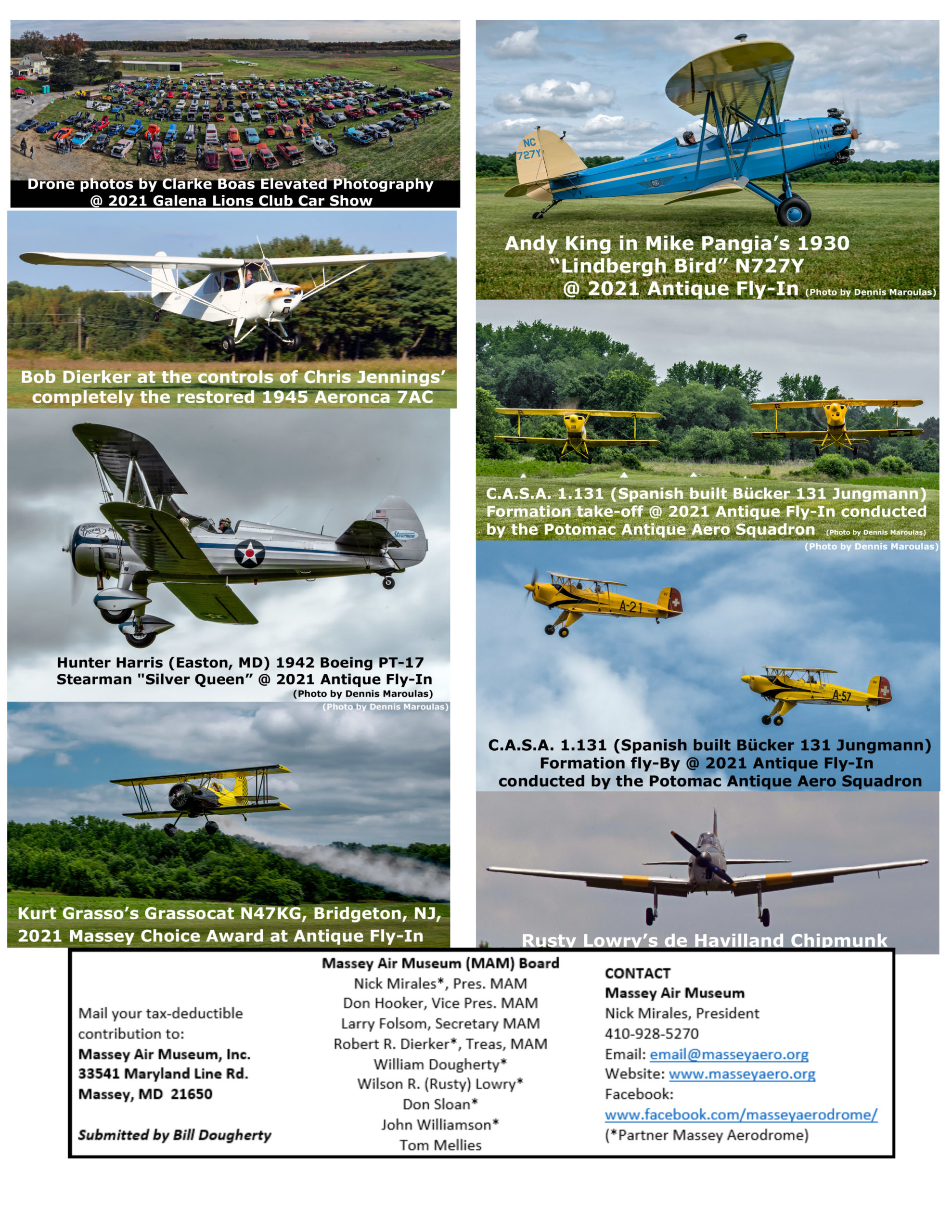 Page 6.
Page 6.
2020 Museum Chatter Newsletter (Jan. 2021)

Page 1.
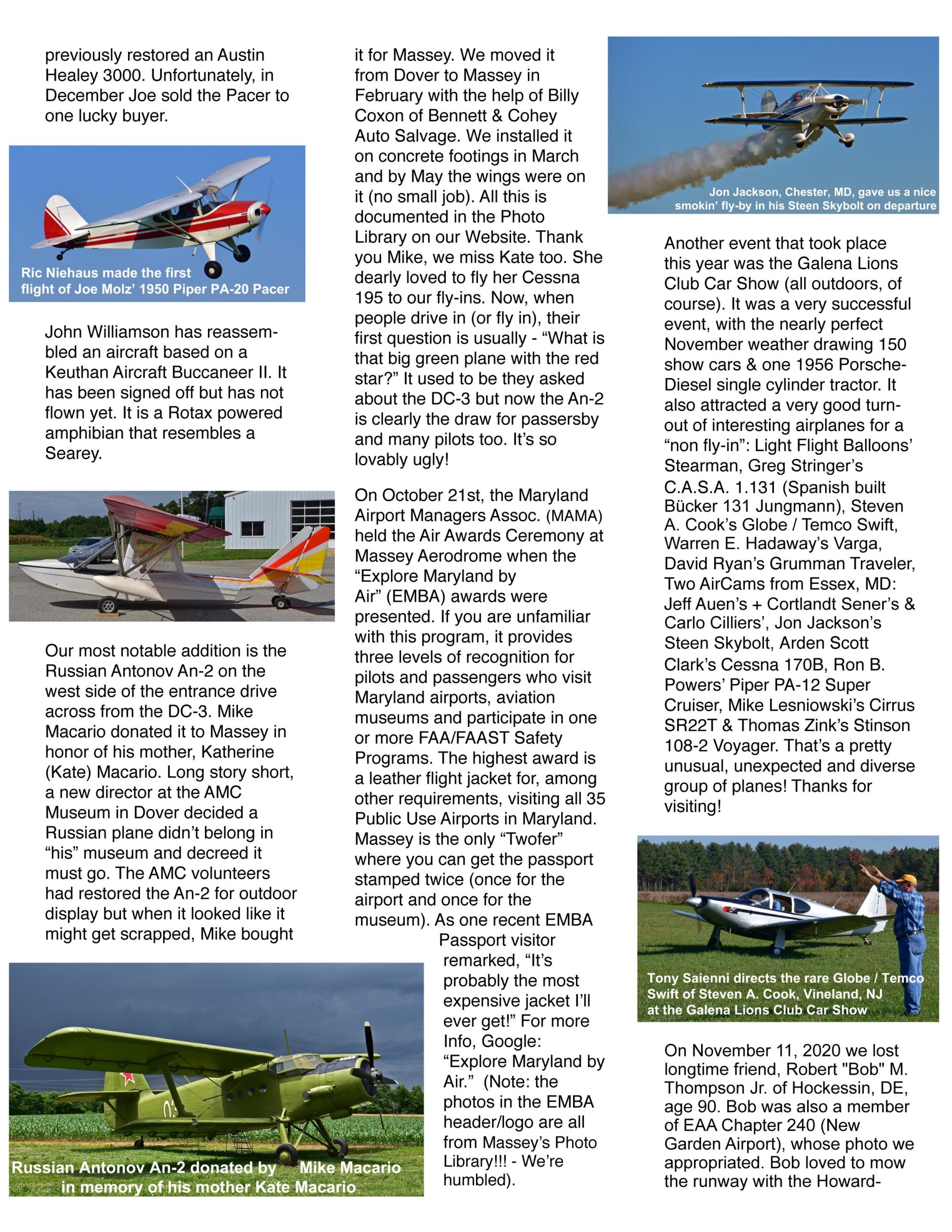
Page 2.
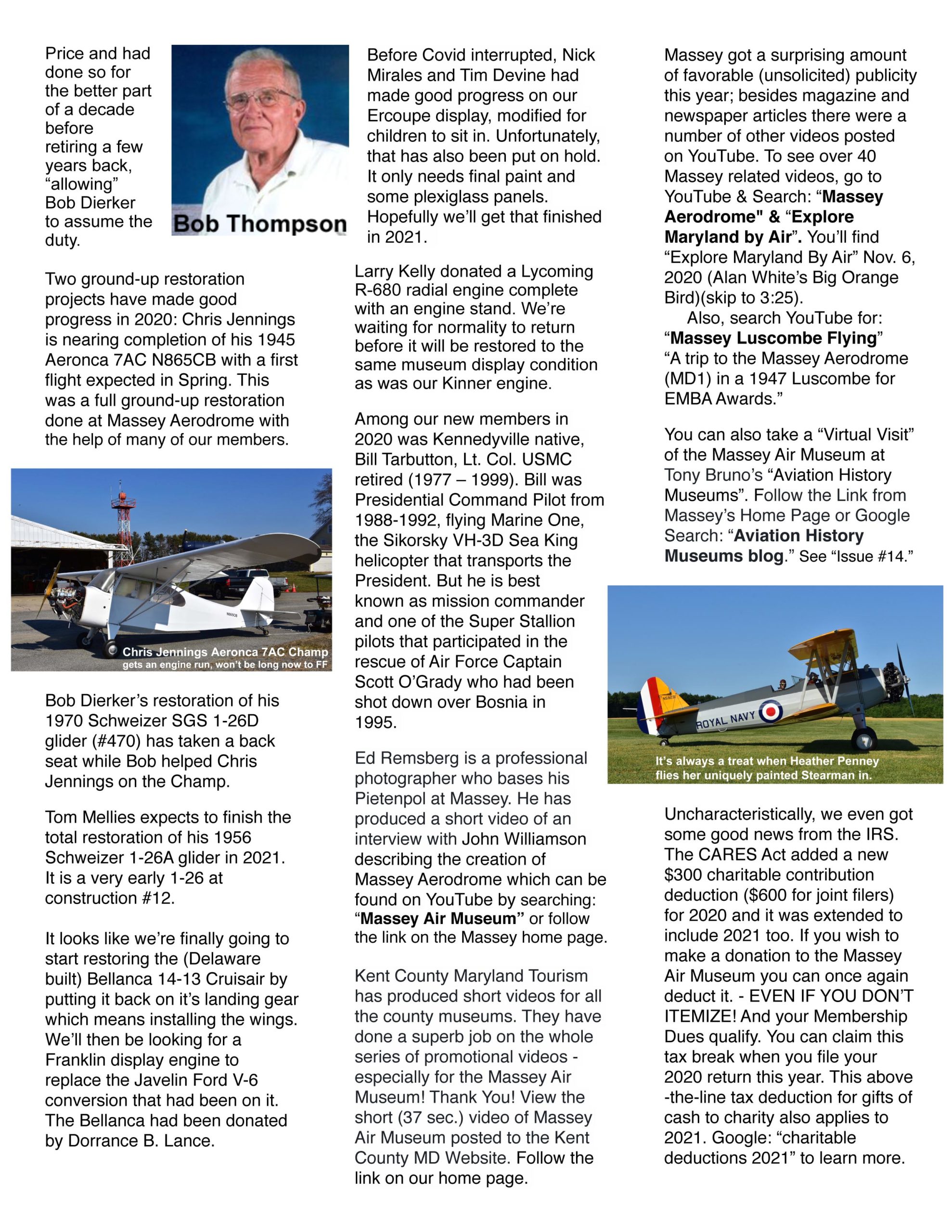
Page 3.
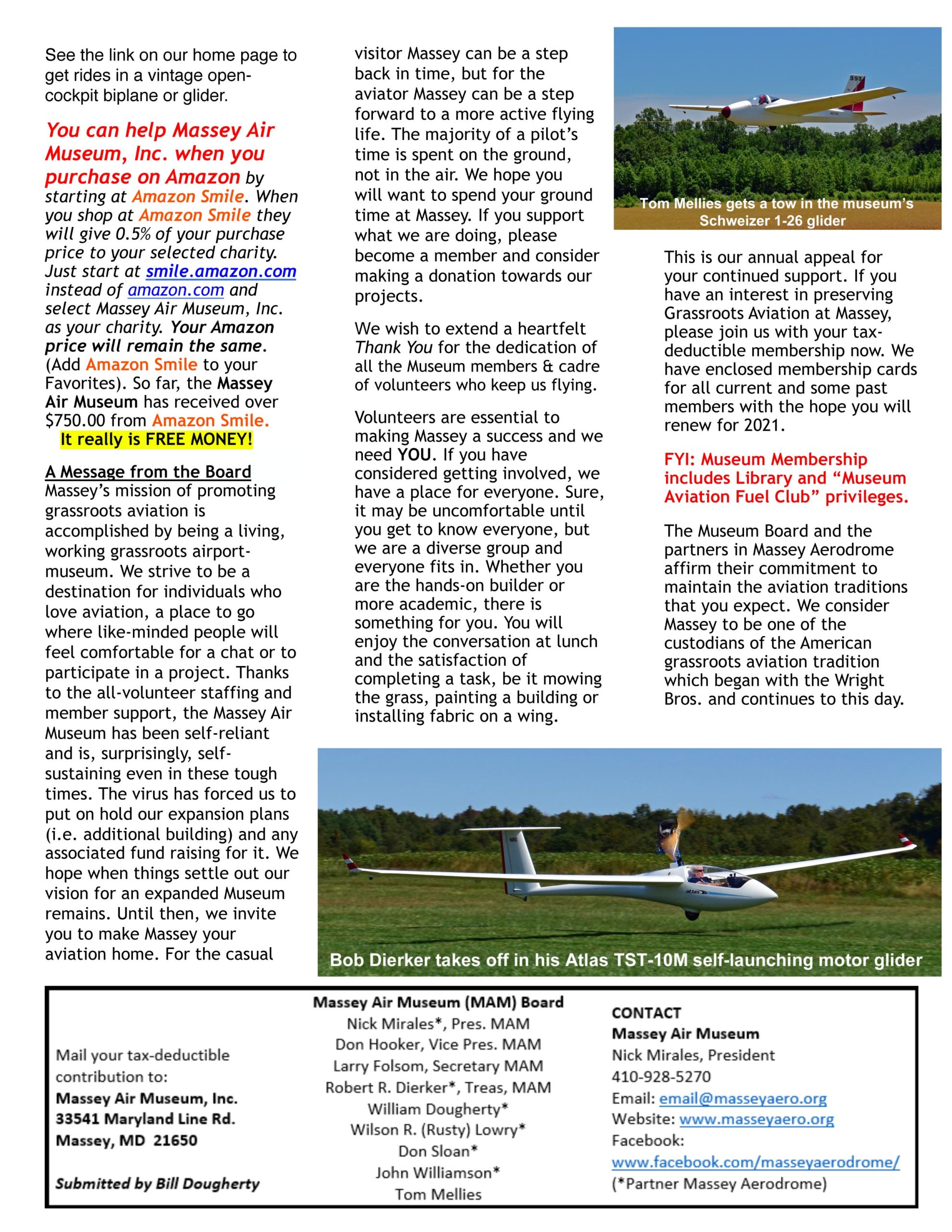
Page 4.
2019 Museum Chatter Newsletter (Jan. 2020)
“Flying Floods” & the Giles Henderson Clipped Wing Cub
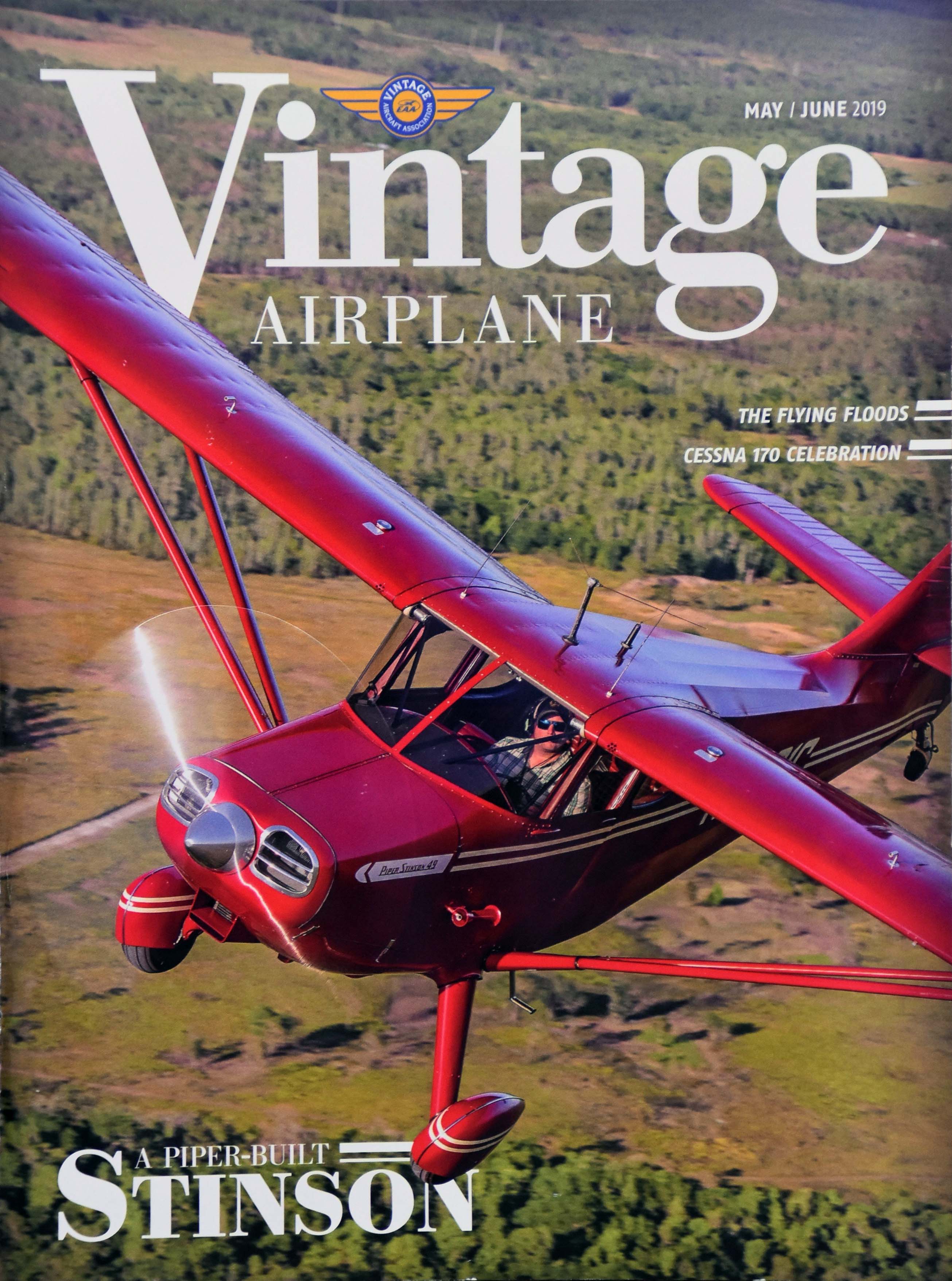 2019 Massey Chili Fest Fly-In (May 11th) Joe Flood & Sons brought 3 of their superb restorations to the Chili Fest from Franklinville, NJ. Read the full 10 page article of Joe & Son’s visit to Oshkosh 2018 in the May/June issue of EAA Vintage Airplane magazine. Giles Henderson’s Clipped Wing Cub, 1939 Aeronca Chief & Piper PA-12 Cruiser. Thanks Joe, it was a privilege to see these planes!
2019 Massey Chili Fest Fly-In (May 11th) Joe Flood & Sons brought 3 of their superb restorations to the Chili Fest from Franklinville, NJ. Read the full 10 page article of Joe & Son’s visit to Oshkosh 2018 in the May/June issue of EAA Vintage Airplane magazine. Giles Henderson’s Clipped Wing Cub, 1939 Aeronca Chief & Piper PA-12 Cruiser. Thanks Joe, it was a privilege to see these planes!
Excerpt from Vintage Airplane article:
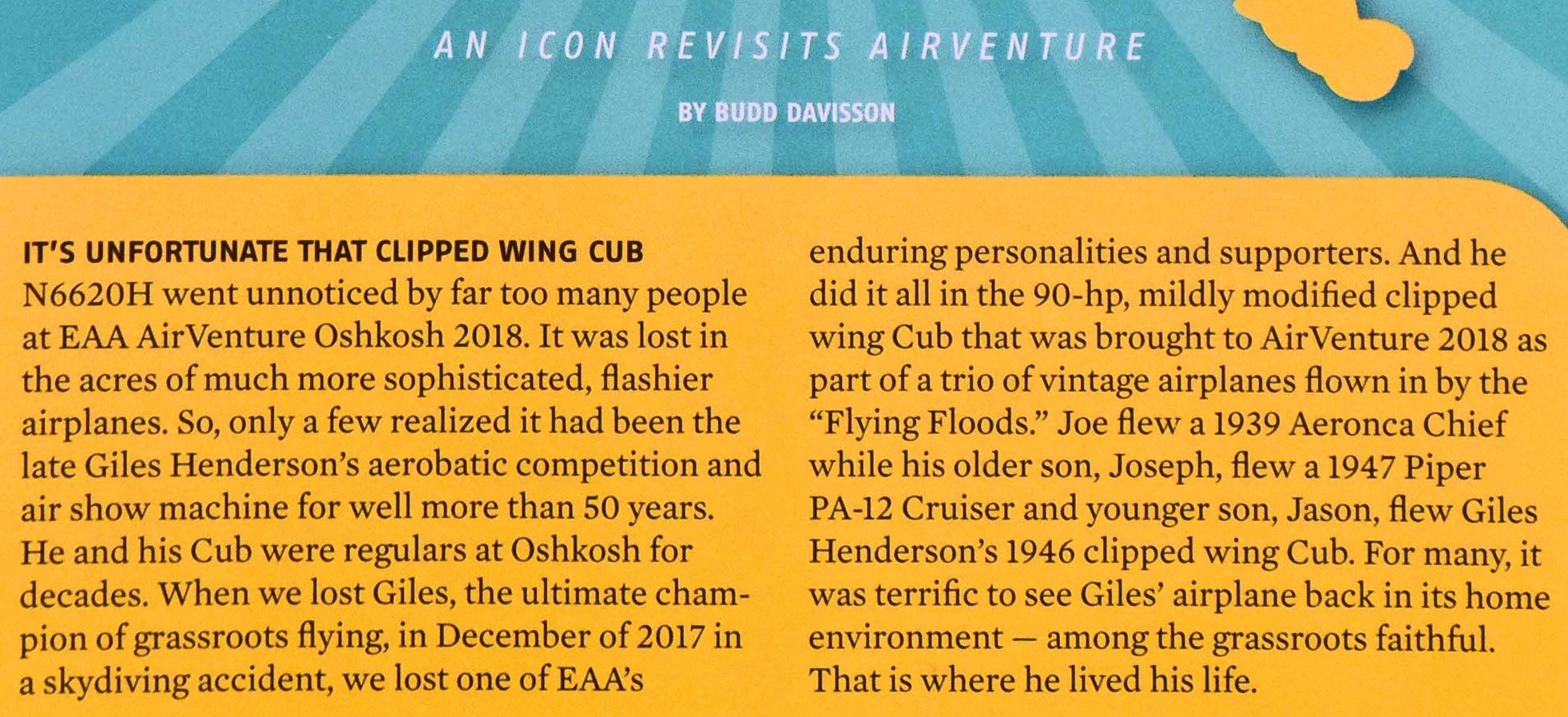
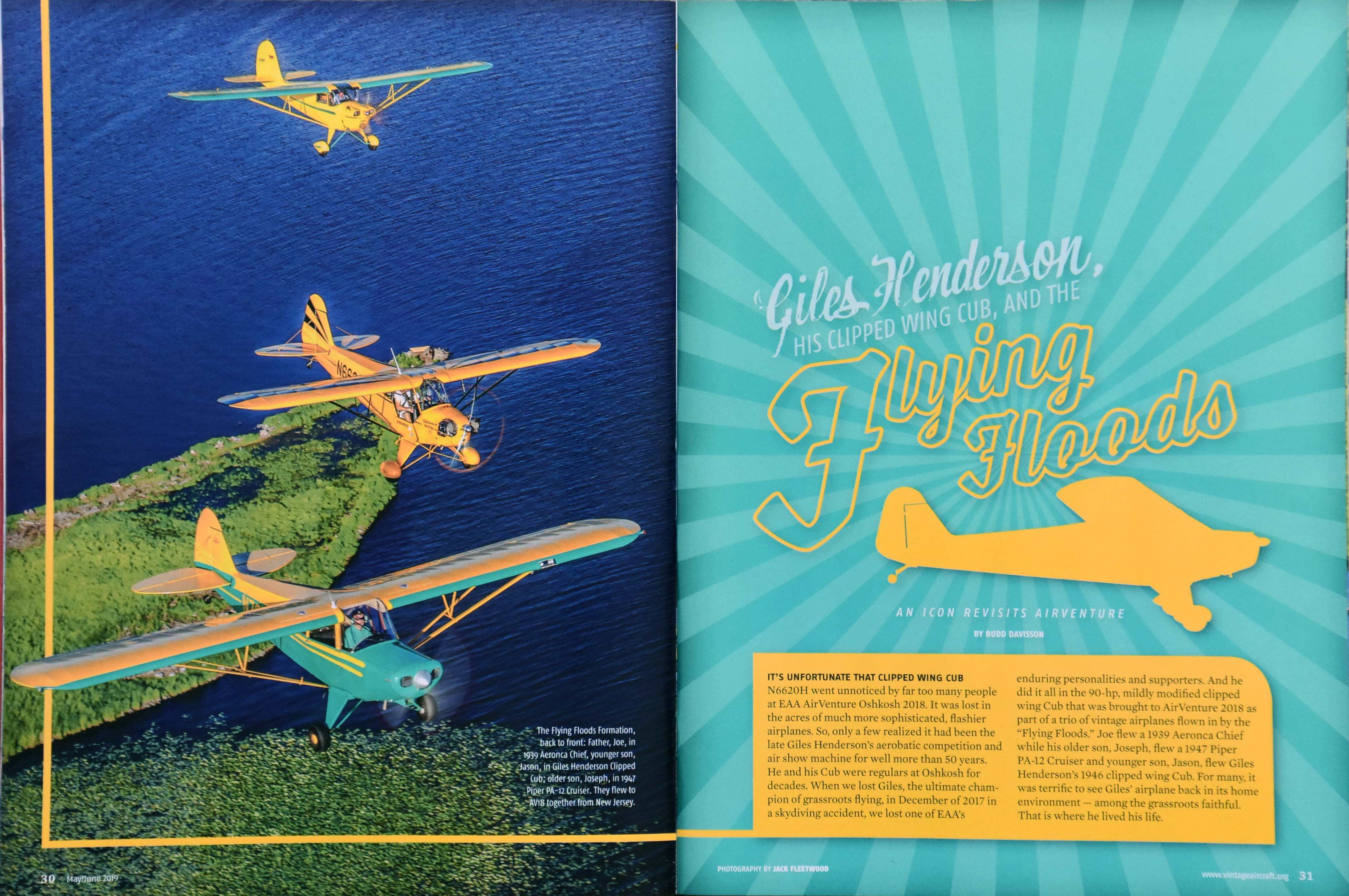
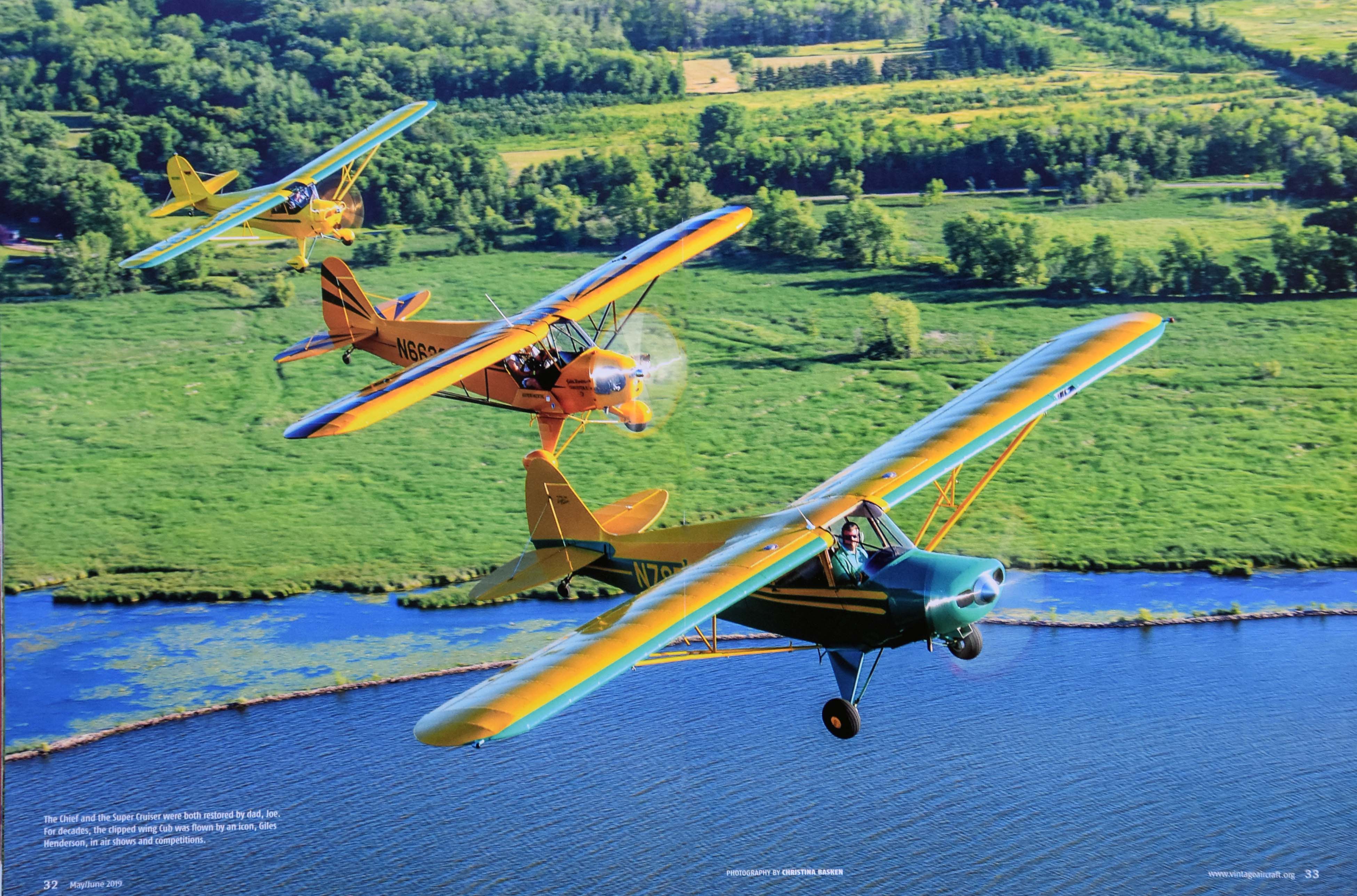
Ferrying Sportsman N124MK Back to the U.S.
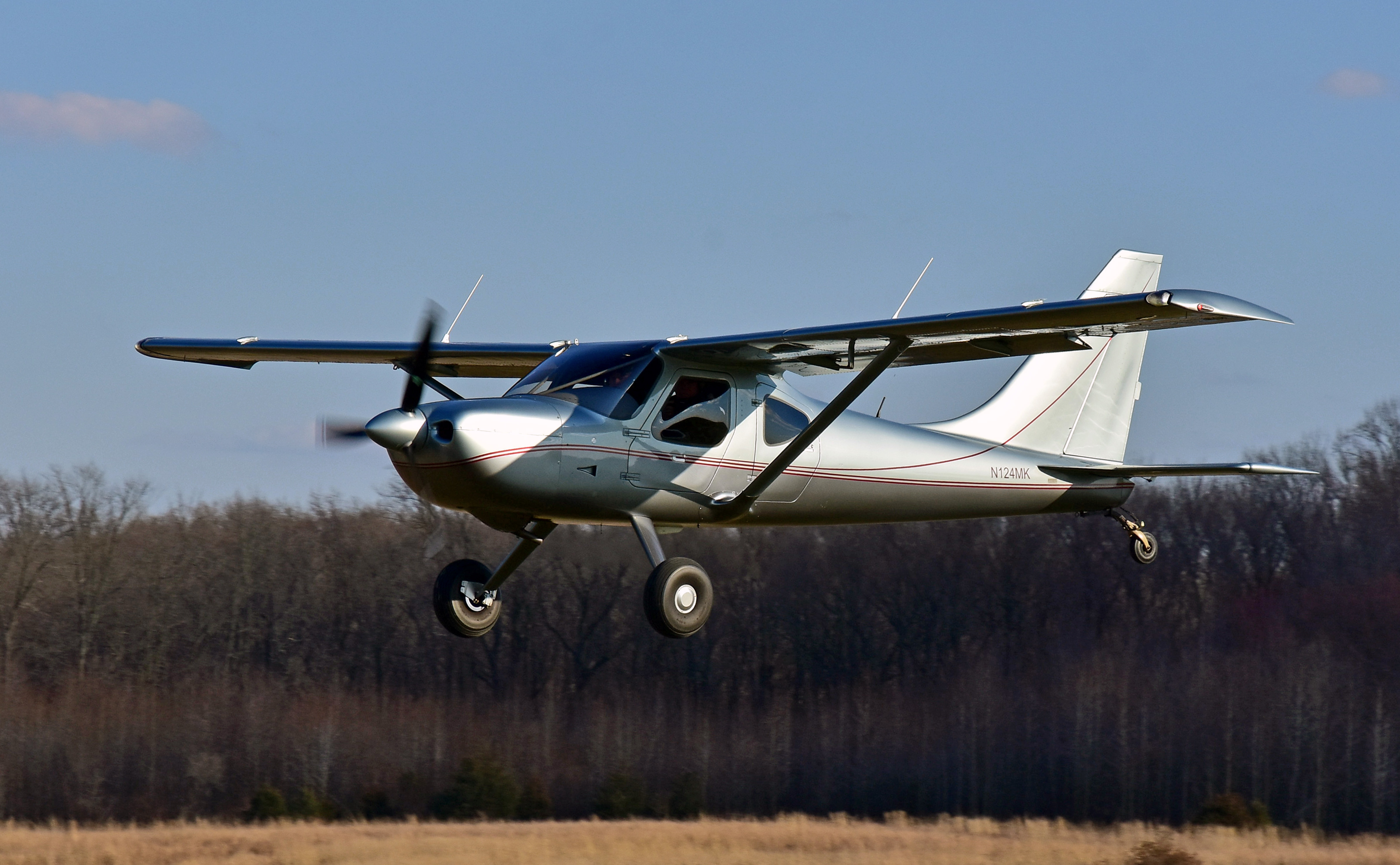
Thanks to Jeff Franklin & Therese Bohusch for bringing N124MK to Massey for a visit.
Glasair Aircraft Owners Association Website Article By Omar Filipovic – September 9, 2017. Link: https://glasair-owners.com/ownership/ferrying-sportsman-n124mk-back-to-the-u-s/
In 2016 Michael Kamber sold his Sportsman to Jeff Franklin, a professional pilot living in North Dakota. The Sportsman was ferried over the North Atlantic—from Switzerland via Scotland, Iceland, Greenland, New Foundland, Maine, to New Hampshire. The airplane was fitted with a 66-gallon ferry bladder providing 14-hour endurance. The ferry pilot, Gerald Childers, wrote reports of of each leg. —Ed.
Introduction by Michael Kamber
After a quite long, and sometimes difficult prehistory*, Jeff (new owner) and I, Michael (builder) engaged with A2B, a reliable and well experienced ferry company to bring the N124MK, a 2011 Glasair Sportsman from Basel, Switzerland to Portsmouth, New Hampshire. The designated pilot Gerald Childers has more than 26,000 hours of experience, 2,400 hours on tailwheel and more then 300 Atlantic crossings logged!
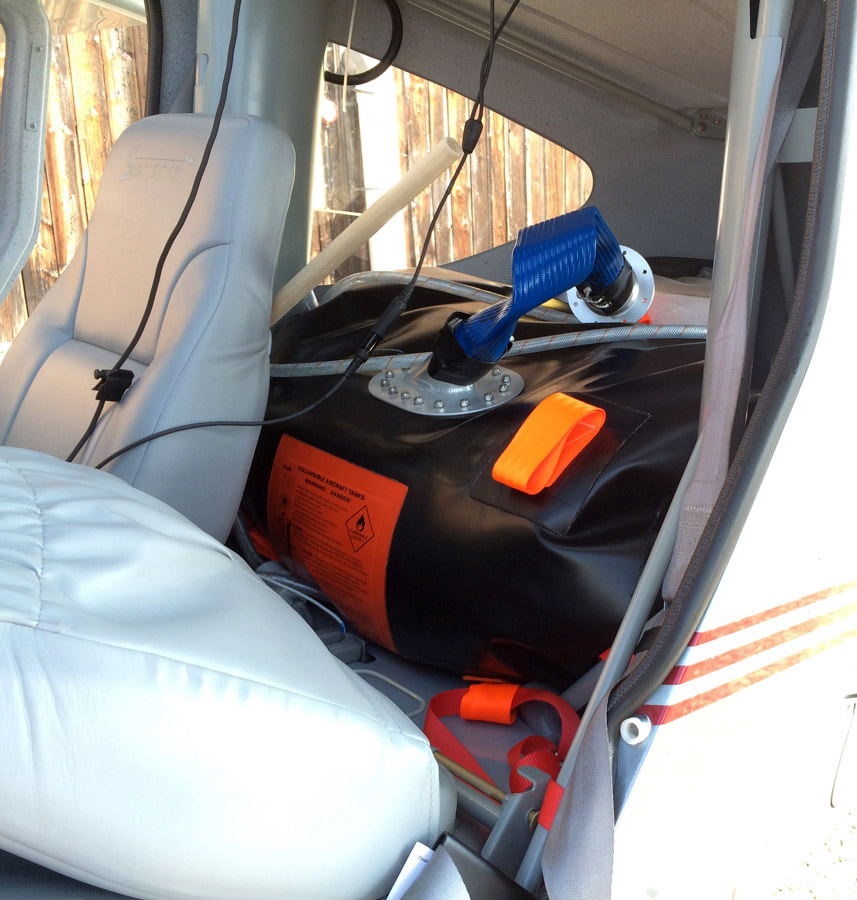 After having a 66-gallon Turtlepac ferry bladder installed (which allows a single stop on the southern tip of Greenland or other alternates) in the back and testing its functioning, we were fully ready, including appropriate insurance coverage and the requested permits from the UK, Denmark (for Greenland) and Canada. Customs were informed.
After having a 66-gallon Turtlepac ferry bladder installed (which allows a single stop on the southern tip of Greenland or other alternates) in the back and testing its functioning, we were fully ready, including appropriate insurance coverage and the requested permits from the UK, Denmark (for Greenland) and Canada. Customs were informed.
Ferry pilot Gerald Childers arrived on Saturday October 24 in Basel and spent an evening with us where he told some interesting stories from his huge ferry experience all over the world. After checking him out on the plane on Sunday morning, he was ready and left Basel for Southend-on-Sea close to London, England on Sunday afternoon.
Gerald’s reports follow below and it’s interesting to see, how flexible you have to be. By the end of September the weather is becoming more and more an issue, as the lows are passing farther South.
Routing: Airports:
LFSB-EGMC LFSB, Basel, Switzerland
EGMC-EGPC EGMC, Southend-on-Sea, England
EGPC-BIRK EGPC, Wick, Scotland
BIRK-BGBW BIRK, Reykjavik, Iceland
BGBW-CYYR BGBW, Narsarsuaq, Greenland
CYYR-KBGR CYYR, Goose Bay, Labrador
KBGR-7B3 KBGR, Bangor, Maine
7B3, Hampton, New Hampshire
Ferry Flight Reports by Gerald Childers
September 25, From Basel to Southend-on-Sea, England
She’s a sweetheart. Good, solid handling in slow flight. Stall warning is a mushiness in the stick rather than any buffet, but the stall itself is mild and straight forward. Michael made a good choice to go to the factory and use their jigs for building the airplane.
On landing, if you reach the three-point attitude just as the wheels are about to touch the ground, you’ll get a squeaker. If you’re off an inch, she’ll let you know about it. But then she’ll forgive you, so that’s all right.
I don’t have any performance figures—I was busy learning the ins and outs of the electronic displays I thought I had mastered. Homebuilts now have EFIS systems airline pilots wouldn’t have dreamed about a few years ago. And nothing exposes your illusions of competence faster than ATC asking you to provide information you knew you knew how to access, and which you now can’t find anywhere. One thing I figured out early is how to engage the autopilot, and that gave me time to explore all the other menus I thought I knew by heart.
There are a couple of things that popped up on the displays as I went along:
– The #4 cylinder EGT fluctuated throughout most of the flight, both digital and analog, though there was half an hour of encouraging steadiness towards the end of the flight.
– Alternator output voltage (“Battery Voltage” with the alternator on line) is a steady 14.6 V, which is at the top of the yellow band. This value only appears if you expand the engine page at least one level, so it might be perfectly normal for this airplane.
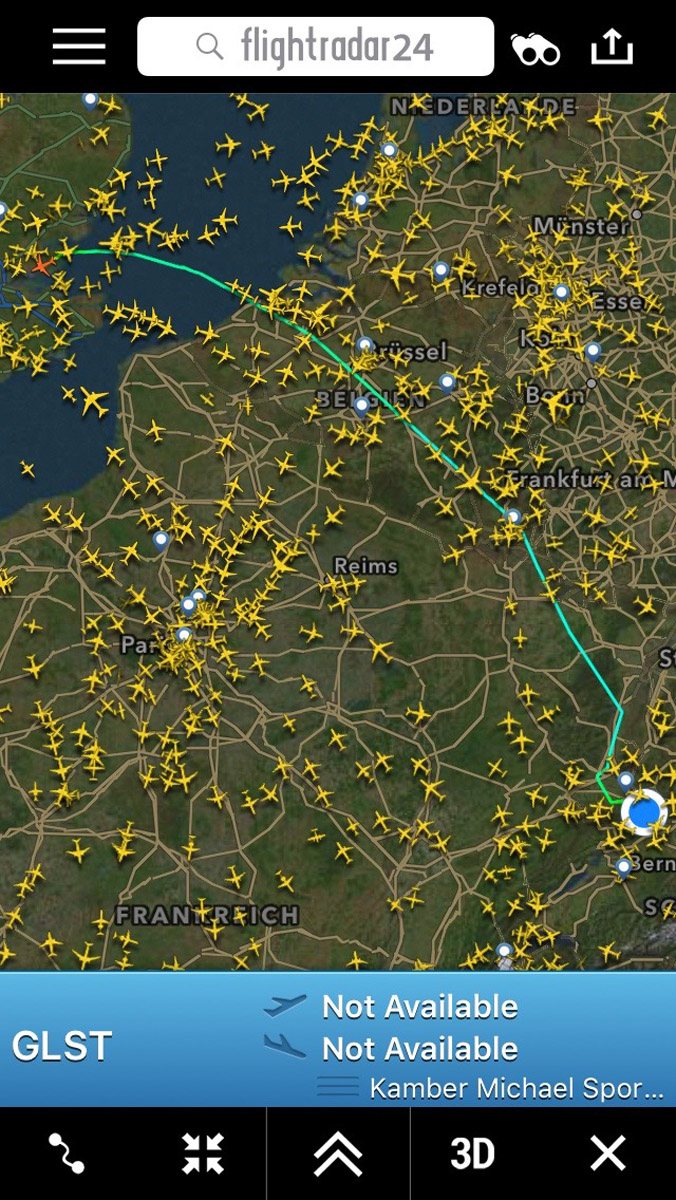 I ate a bellyful of headwinds this leg. The nearer I came to Southend, the slower I went, until it seemed as if I were caught in one of Zeno’s paradoxes and would never arrive. But I did arrive at last, and I shot a straight-in ILS to Runway 23 (in perfect weather) with plenty of time to figure out how to get the localizer and glideslope onto the display. Just in case I need them later on…
I ate a bellyful of headwinds this leg. The nearer I came to Southend, the slower I went, until it seemed as if I were caught in one of Zeno’s paradoxes and would never arrive. But I did arrive at last, and I shot a straight-in ILS to Runway 23 (in perfect weather) with plenty of time to figure out how to get the localizer and glideslope onto the display. Just in case I need them later on…
I don’t see any way to get my trailing-wire antenna out of the airplane without making a hole in it, which I won’t do. I’ve got a good tuner with me, and there are hardware points for pinning the wings when they’re folded that I could use to anchor a fixed antenna, but we’ll probably have to build a stand-off of some sort for the wing top to keep the wire from impinging on the aileron.
WetterZentrale’s Niederschlag forecasts still indicate I should be able to run up to Wick ahead of the weather tomorrow. Tuesday looks like it might not be a good day for Iceland, though: rainy weather propelled by a burst of westerlies roaring up from 45° North. After that blows by the chances look fairly good for the subsequent legs. We’ll see.
September 26, From Southend-on-Sea to Wick, Scotland
At FL100, full throttle (20.8″ MAP) and 2500 RPM, leaned to, at most, 45°F lean of peak EGT, gave me 61% power and resulted in 120 KTAS at 8 GPH. That’s not bad. If I could be sure of getting every drop of fuel out of the ferry tank it would give me 13-1/2 hours of endurance, with a bit taken off for the climb; With a hint of a tailwind that would get me nonstop from Reykjavik to Goose. That’s something to consider, but not anything to count on. Thursday’s winds are forecast to be mostly confused, with a sweep of crosswinds out of the northwest over the Davis Strait—so, no tailwind, but not much headwind, either.
I believe I’ve figured out how to install my HF. It’ll be a short antenna, because I’m not confident I can fabricate a stand-off for the wing tip that would be tall enough to keep the wire off the aileron and still be aerodynamically innocuous. But I’ve got a good tuner, and anyhow there’s a big difference, when asked if I’ve got an HF installed “as required on this route,” between saying, “No,” and saying, “Yes, but somehow I haven’t been able to talk to anyone on it today.”
The airplane’s in the hangar, so the only precipitation it’ll be exposed to tomorrow will be from the pigeons. That’s where I’ll spend much of the day, playing with my tools, and trying really hard not to drop a screw into an inaccessible location.
September 27, Wick, Scotland
Guess what I accomplished today. Give up? I hooked up a wire, that’s what I accomplished.
Well, first I found a ground. I looked high and low for bare metal, and found only paint. I finally decided to use the same ground the ferry tank installers used for the ferry fuel pump. In the bottom of my tool bag I found a longer bolt that I swapped with the original, so I could add all my ground wires (HF power, HF chassis, HF antenna) to the fuel pump ground.
Then I hooked up the power lead for the HF. The glareshield pops right off in this aircraft, and you can look through the windshield at the back of the circuit breaker panel. It’s all right there, in plain view. It looks so easy! (I wish I’d thought to get a photo.) But in fact the windshield gets in the way when you try to reach around to the screws and bolts, and the airframe structure gets in the way when you try to see what you’re doing. If I watched what I was doing through the windshield, I’d need arms about two feet longer with three more elbows.
I know you’ve heard all this before. This is the typical complaint from people working on airplanes. The bit about needing more elbows probably goes back to the Wright brothers. At least you don’t get all greasy, or have dirt falling in your eyes. But in fact this power drop installation was the easiest-looking and the most difficult to accomplish of any I’ve had in twenty-five years of ferrying. When I finished I was exhausted, but very, very pleased I’d been successful.
The rest of the HF installation should be more straightforward, and I might be able to finish the job tomorrow afternoon in Iceland. That’s not a prediction—it’s a hope. Maybe it’s a fantasy. We’ll see.
I’m not going to check the weather tonight. It is what it is, and I’ll need to check the latest information in the morning anyhow. I’ve just had a nice meal in Wick’s charming little French restaurant, Bord de l’Eau, and I’m just going to go to bed with a happy tummy and get up early in the morning. But what I’ve seen so far suggests a morning departure for Iceland might be a good idea.
September 30, From Wick, Scotland to Reykjavik, Iceland
I had a good flight, on top all the way at FL100 (sometimes just barely), 30-knot headwinds gradually shifting to crosswinds.
The Olís avgas pump malfunctioned in the morning, so I had to taxi across to the pump at the T-hangars, and boy, did the little girl attract a crowd of admirers!
I’m looking at the weather from here to Goose Bay, and scratching my head. I’m seeing a small low off the east coast of Greenland, which maybe has been moving south but is forecast to settle in just east of Cape Farewell. There’s a medium low down around 50°N that’s forecast to move north-northeast and then northwest to join the small low and form a ferocious storm by midnight Monday morning that’s expected to persist until Tuesday before it starts to fill.
 I could go to Narsarsuaq tomorrow skimming the top of that small low, but I’m concerned about what weather that might push up onto the ice cap and whether I could get over it in the Glasair. Kulusuk would be available (i.e. open) for an alternate, but it’s likely to be affected the same way. I’m thinking I might want to go non-stop to Søndre Strømfjord and then south to Goose. That’s pretty far out of the way, but it beats being stuck here for a week, and it would probably keep me away from the effects of that Cape Farewell low, and then the leg to Goose would have the winds roaring down the Davis Strait somewhat behind the wing.
I could go to Narsarsuaq tomorrow skimming the top of that small low, but I’m concerned about what weather that might push up onto the ice cap and whether I could get over it in the Glasair. Kulusuk would be available (i.e. open) for an alternate, but it’s likely to be affected the same way. I’m thinking I might want to go non-stop to Søndre Strømfjord and then south to Goose. That’s pretty far out of the way, but it beats being stuck here for a week, and it would probably keep me away from the effects of that Cape Farewell low, and then the leg to Goose would have the winds roaring down the Davis Strait somewhat behind the wing.
The guy at reception advised me I’d better eat early, because the restaurant here (at Hotel Ódinsvé) is going to fill right up on this Friday night. So I’ll go eat now, and resume my head-scratching after.
It’s safe to bring the airplane out of the hangar now, but the strong headwinds to Iceland would leave me pushing darkness by the time I arrive, which I don’t want to deal with in this airplane. So I’ll leave in the morning, and hope to push through to Goose Bay on Saturday.
October 1, Reykjavik, Iceland
I recorded some power settings on the way from Wick to Reykjavik. I had to throw the first batch out because the mountain wave off the Highlands interfered with the results, but the second batch was taken about two thirds the way to Reykjavik in the lightest winds of the leg, 10 knots from the southwest (no mountains in that direction!). These were all taken at FL100 and -9°C, density altitude 9,400 feet, full throttle, between 45 and 50 degrees lean of peak on the leanest cylinder, and with about 80 gallons on board plus me and all the equipment.
| MAP | RPM | % Power | KTAS | GPH |
| 20.9 | 2200 | 57% | 119 | 7.5 |
| 20.9 | 2250 | 60% | 122 | 7.8 |
| 20.9 | 2300 | 61% | 123 | 8.0 |
| 20.7 | 2400 | 62% | 123 | 8.1 |
| 20.7 | 2500 | 63% | 123 | 8.3 |
If I were to do this again I’m sure the results would be subtly different, but we can learn some things from this table. Notice how between 2250 and 2200 RPM the power, speed, and fuel flow fall off appreciably. Above 2250 the power does increase with RPM, but not much, and I think the internal friction of the engine reduces the power output at higher RPMs. The fuel flow increases steadily, but the airspeed much less. I wouldn’t be surprised to see 124 KTAS at 63% from another run of these power settings in the exact same conditions, but the tale of the table is you don’t get much for your increased half gallon per hour. To me, in still air or tailwinds or even light headwinds, the best deal at high altitudes is full throttle and 2250 RPM.
I’ve run power settings tables for turboprops several times, but somehow never did it for normally-aspirated pistons. I think of all those hours I sat there listening to an engine at 2500 RPM, when I could have had a quieter, smoother ride, and been easier on the engine at the same time (no small consideration when it’s all there is between you and the water).
Winds tomorrow morning 0900-1200 130 18G28, so I’ve moved the airplane into the lee of the building.
October 2, Reykjavik, Iceland
I wasn’t counting on that part of the building being a garage for snowplows with a sign prohibiting aircraft parking. I’m sure I could have got permission from the tower since the snow is a few days away this year, but I actually found a better shelter, with the airplane nosed into the angle of the Flugþjónustan building pointing southeast into the expected wind, and with a double barrier of the hotel and tower, and then the smaller building itself.
October 7, Narsarsuaq, Greenland
A slow internet: I closed some of the weather-related pages on my computer and re-booted it, to see if that would help. Meantime I went and ate breakfast before they shut it down.
What I’m seeing on the (I confess) gramets is an easy flight until the coast, and then the weather around that 1008mb low. That’s not the lows we’ve been dealing with, but I still have trouble with the idea of layers in a low—that air is rising, after all—and the gramets don’t show any (I ran a couple of projections 3 hours apart). The one for a 20Z arrival at Goose shows the cloud mass much reduced, but still 3 to 5 thousand feet thick, with icing throughout. It also shows the air clear below 5,000 feet, but Goose’s TAF predicts no ceiling higher than 2,000. Now, I’m happy flying under a 2,000-foot ceiling over recently wetted ground if there’s an airport every 20 miles I could duck into if the mist starts to rise. But that’s not the case here. I’d go into Gander, which has much better weather, but I need to turn in the life raft at Goose.
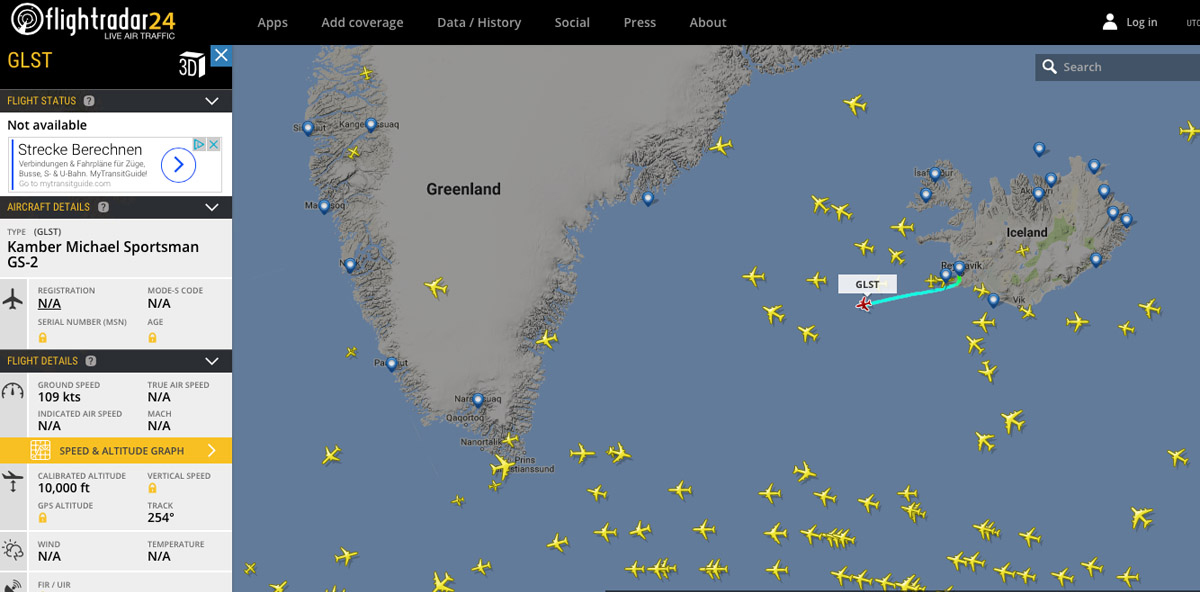 So what I’m going to do is re-fuel the airplane today and file a flight plan for tomorrow at 08:00 local/1000Z, when the airport opens for the day. The gramet shows clear sailing, with the freezing level rising to 10,000 feet over Labrador, and the projection to Bangor shows good weather and a 10,000-foot freezing level all the way. The headwinds will be ferocious—though not much worse tomorrow afternoon then they’ll be tomorrow morning—and the last hour or two of the flight will be after dark. But a night landing in good weather is a lot different than a night landing in the clag.
So what I’m going to do is re-fuel the airplane today and file a flight plan for tomorrow at 08:00 local/1000Z, when the airport opens for the day. The gramet shows clear sailing, with the freezing level rising to 10,000 feet over Labrador, and the projection to Bangor shows good weather and a 10,000-foot freezing level all the way. The headwinds will be ferocious—though not much worse tomorrow afternoon then they’ll be tomorrow morning—and the last hour or two of the flight will be after dark. But a night landing in good weather is a lot different than a night landing in the clag.
I’ve received the latest Jepp icing chart, and it looks good. But it still shows that low hanging around Goose Bay like a hoodlum, and the gramet shows the freezing level still low, and, once again, the TAF says OVC020. (The weather here in Greenland is great, altostratus at 11,000′ or so.). So I’ll stick with the overnight here and then Goose/Bangor tomorrow.
P.S. With all the information available to us now, and especially with a slow internet, it sure can take a long time to properly study the situation. I don’t think it’s happened today, but I can imagine, as you’re going from chart to chart and evaluating different scenarios, a window of opportunity might open and quietly close again while you’re still scratching your head. This is one reason talking to a (good) briefer can be helpful: he’s already studied the charts, and has the meteorological mise en scène in his mind, so all he has to do is try to fit your various proposals into it, or suggest some that might fit it better.
October 7, Narsarsuaq, Greenland
Narsarsuaq has FEW080, and they’ve published a TAF this early in the morning: SCT100. Goose has a ceiling at 2,600′, forecast to be between 3 and 4 thousand, generally rising and layered, until 17Z (about the time of my arrival), when the clouds will be scattered and the winds somewhat gusty at 21015G30KT. That’ll be the passage of a pretty dry warm front, and I’ll be flying down to Bangor just ahead of the cold front into the teeth of the wind. I think I’ll go at 6 thousand feet rather than 10, since part of the time the winds will be lighter down there.

The gramets show clear sailing and a high freezing level all the way, and of course, the headwinds.
Bangor’s forecasting clear skies throughout the day and—even with 40-knot winds at 5,000’—very light winds on the surface. I expect to arrive there around 0100Z/21:00 tonight. I’ve already filed the eAPIS, and Bangor Customs just wants a phoned-in ETA just before I leave Goose.
Hurricane Matthew is expected to curve back south, but WetterZentrale shows its associated precipitation continuing up the coast, gradually moving offshore. We’ll see.
October 9, Goose Bay, New Foundland
The airplane was frosty this morning. Not quite furry, but a good 2 or 3 millimeters, enough to make me serious about cleaning the leading edges. A rag soaked in a little gasoline from the sumps took care of those, and a hotel key card inadvertently carried away from the hotel and saved for just this purpose took care of the windshield. Those key cards are perfect, because they’re softer than the plexiglas. (The card I used must have been made of pressed cardboard, because it was used up when the windshield was clear.)
It’s a little airplane (and cute, did I mention that?), but it took some rubbing to make the plane safe for takeoff, and that took some time. I lost some more time playing phone tag with Customs, but I did get that straightened out in the end. And I finally took off two hours later than I had intended.
The flight itself was routine, except for the frustration with the HF. I could hear Gander on 8864 as if he were sitting next to me, but he couldn’t hear me. A couple of times he said, “Aircraft calling Gander, say again your call sign.” And, hope springing up in my breast, I would say “November 1 2 4 Mike Kilo,” very slowly and distinctly, and then I would let up on the mic button and hear him answering some other aircraft! Aargh!! At seven or eight feet, that antenna is just too short, but there was no way to let my (200-foot!) trailing wire antenna out of the airplane in flight, and I really don’t think I could have mounted a longer fixed antenna. Anyhow, I’m here, and I haven’t been asked to call ATC and explain why I flew that route with no HF.
Before I reached the coastline I flew into some weather. It was mostly snow—I had dim ground contact once I passed the coast—but there were some clouds at FL100, too, and the temperature was below freezing. I let down to 8,000, and then 6,000, where the temperature was +2°C. It gradually rose to +9°C, as the winds backed to the west and increased to 40 knots on the nose, and I was grinding along at 80 knots.
And then a marvelous thing happened. The ATIS for 16Z reported a 4,000-foot ceiling with scattered clouds below. The ATIS for 17Z reported scattered clouds, a ceiling of 25,000 feet, and gusty winds—exactly on schedule! I understand a little bit about how forecasts are made, but I’m always amazed then they hit the nail on that little flat spot on top.
The wind on landing was a 40-degree crosswind gusting to 22 knots. The little lady fussed at me for not making a perfect landing, as she always does, but she didn’t go so far as to dart suicidally for the ditch. I parked her in the lee of some buildings, facing into a wind that quickly faded away to a zephyr.
Bangor is forecasting some weather as the cold front passes, then clear after noon. The winds tomorrow are forecast to be less than today at 5,000 feet (though there’s no relief at 10,000). And if I continued to Bangor I’d have landed way too close to midnight for this old fogey. So I’m spending one more night on the road.
I made sure that the Spot tracker was oriented correctly today. I started to change batteries this morning, but I found I was out of fresh lithium batteries, and there’s a placard on the device requiring lithium batteries only, so I chickened out. I’m going to try to find some lithium batteries in Goose Bay, and if I can’t I’m going to pretend I’m an Italian and just toss in whatever I have on hand. I never got a red light on the LEDs, but I still think it must be the batteries.
October 12, Bangor, Maine
I had a good chance to check the accuracy of the gramet forecasts today. They did pretty well. The clouds over Labrador were lower than predicted, but from Quebec south they got it just about right. Bangor had been forecasting a 2,500′ ceiling for the time of my arrival, but that was revised to reflect what the gramet had been predicting all along. The headwind and tailwind components were close, too. But they showed the freezing level rising over New Brunswick to reach 10,000′ at Bangor, and that never happened: I was in plus temps all the way, but at 4,500′ the OAT was +3°C, and I think the freezing level never rose much above 5,000′.
Shortly after takeoff I climbed to 4,500′, but I soon had to duck back under at 2,500′ to stay in VMC. But the visibility was superb. I only fly low over Labrador when I have to, but when I have to I always enjoy it. For 200 miles on this route, from near Goose Bay to just north of the St. Lawrence, there is no sign that mankind has ever existed on the earth.
You’ll notice the 2,500′ yellow line on the gramet is scraping the hilltops north of the St. Lawrence. At that point the GPS was getting nervous about the terrain, and the beautiful dove-gray leather on the glare shield was reflecting in the windshield, making it hard to see ahead, so I climbed to 2,800′ for a bit of margin, still staying below the worst of the headwinds.

I had forgotten to call Bangor Customs with an ETA at Goose, so when I was approaching Havre St. Pierre, on the north shore, I coupled my phone to my headset with Bluetooth, and started checking for a signal. Twenty miles north of town I had two dots/bars of signal strength, and calling them was easy. Ain’t technology wonderful?
At the St. Lawrence I climbed to 4,500′, to give myself more time if there was a problem. The sky was wide open at this point, but I had to accept a 10-knot increase in headwind component, to 15-20 knots. Still not nearly as bad as the 50 knots I was facing yesterday. Over New Brunswick I was happy to see the colorful leaves hadn’t all fallen off the trees in my absence.
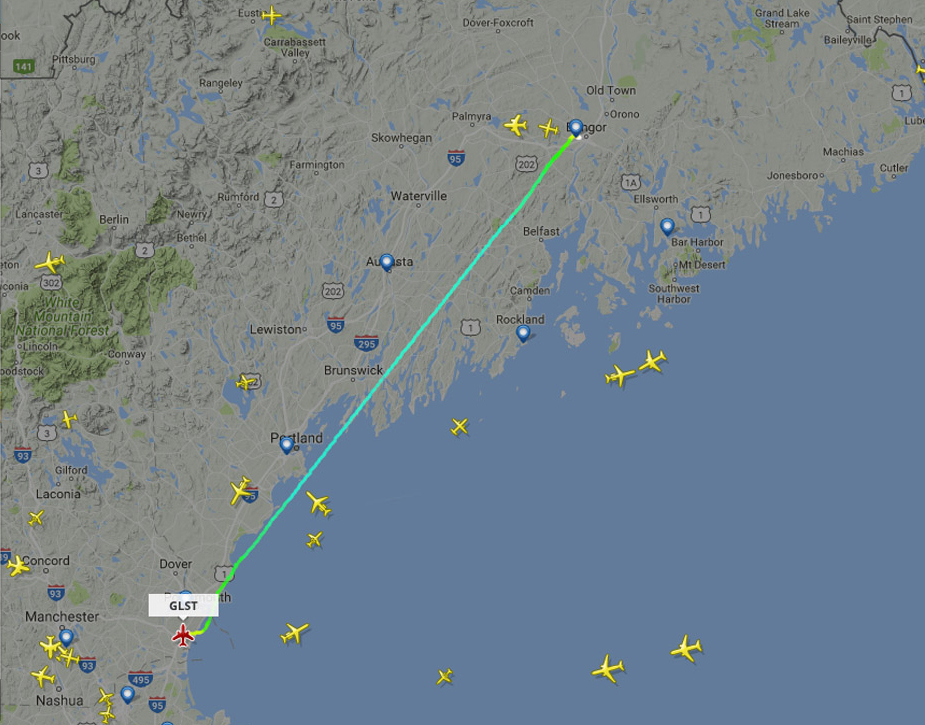 There was moderate rain from Houlton on, so I got an IFR clearance at 4,000′. I was below the ceiling all the way, but visibility was reduced in rain, and it was very comfortable to be IFR. I made a visual approach to Runway 33 at Bangor, taxied to the designated Customs inspection spot for the formalities, then tied the airplane down for the night.
There was moderate rain from Houlton on, so I got an IFR clearance at 4,000′. I was below the ceiling all the way, but visibility was reduced in rain, and it was very comfortable to be IFR. I made a visual approach to Runway 33 at Bangor, taxied to the designated Customs inspection spot for the formalities, then tied the airplane down for the night.
I expect to deliver to New Hampshire tomorrow. Jeff and I are coordinating our plans.
=======================================================
Massey Aerodrome visit March 17, 2019
Last Sunday (3/17/19) we were treated to a visit by Jeff Franklin & Therese Bohusch (both are pilots and co-owners) in a rather special aircraft: a Glasair Sportsman GS-2 with 195 HP Aero Sport IO375 engine. Before they landed, while they practiced cross-wind landings we were attracted to the throaty sound of the engine but no one could identify what it was although we all knew what it wasn’t. We learned that this plane was built taking advantage of the factory two week to taxi program, shipped to an architect in Switzerland then ferried back to the states when Jeff & Therese bought it. They kindly offered a ride to everyone who wanted to take a ride – very generous! It is a most impressive aircraft, the acceleration pushes you back in the seat, the dual EFIS will convince anyone who sees it and although not an instructor, Jeff explained everything in a clear and concise manner that would make any student comfortable. Thanks for topping off a nice day at the airport, please come back! Later, on the The Glasair Aircraft Owners Association Website, we found this very interesting article about the ferry flight that I hope you enjoyed reading: Ferrying Sportsman N124MK Back to the U.S. https://glasair-owners.com/ownership/ferrying-sportsman-n124mk-back-to-the-u-s/
Recommended Reading (Top 10 Lists)
On seeing a “Top 10 Aviation Books” list, I was curious how many we had in the Massey Library and it turns out we have 9. Here is that list plus two more FYI.
() = Massey Library catalog #
Top 10 Aviation Books Written by Claire Ellis 27 July 2018 https://www.aircharterservice.com/about-us/news-features/blog/top-10-aviation-books
Looking for a great book about flying? Here are 10 of the must-read books about aviation, perfect for both professional pilots and aviation fans. There’s something to suit all tastes, whether you’re looking for a pilot manual, flight history or fiction. Top picks include the fascinating true stories of wartime pilots and the first trans-Atlantic crossing.
Stick and Rudder: An Explanation of the Art of Flying – Wolfgang Langewiesche (IF.41)
Stick and Rudder is one of the most famous pilot manuals and has been in print for over 70 years. The writer walks you through the process of flying, explaining what the pilot does, how he does it, and why. Learn all about why airplanes stall, what the rudder is for, why the aeroplane doesn’t feel the wind and more. Since the basics of flying haven’t changed since the book was written in 1944, it remains a popular text for professional and trainee aviators as well as test pilots.
The Wright Brothers – David McCullough (BIO.WRI)
Read the true story of Wilbur and Orville Wright, two unschooled Ohio boys who changed the course of aviation history. This inspiring tale was written by Pulitzer Prize winner David McCullough and draws on private diaries, notebooks and over 1,000 family letters. Learn about the engineering process and death-defying trials that went into creating the first real aircraft. This is one of the most inspiring history books about aviation, which illustrates the courage and determination that led to the brothers’ first flight in 1903.
Weather Flying – Robert N. Buck (IFW.14)
This is one of the most technical books on the list, considered the bible of weather flying. Buck draws on his experience as a commercial pilot with thousands of hours in the air to describe techniques for flying in various weather conditions. Sections include weather research, the psychology of flying, techniques for flight forecasting and taking off in bad weather.
The book has been updated five times and includes the latest advances in flight weather services, including radar. This is a good read for both aspiring and professional flyers, with simple explanations on how to judge and negotiate weather conditions. Weather Flying won the Safety Foundation’s Publication Award and is recommended by the FAA.
The Spirit of St. Louis – Charles A. Lindbergh (BIO.LIN)
Charles Lindbergh is famous for his solo nonstop trans-Atlantic journey from New York to Paris in 1927. This autobiographical account of the landmark flight details the thrilling danger of Lindbergh’s journey in his single-seat, custom-built aircraft: the Spirit of St. Louis. The Pulitzer Prize-winning adventure tale gives readers a glimpse into the history of aviation before the days or commercial flights and air charter services.
Fate is the Hunter – Ernest K. Gann (BIO.GAN)
This illuminating biographical tale covers Ernest Gann’s life as a pilot during war and peace times. Gann has spent nearly 10,000 hours in the air, including flying for American Airlines in the 1930s, which gives a captivating insight into the history of commercial flying. During the second world war, he flew cargo missions across the Atlantic and also made white-knuckle flights across Asia and the Himalayas. Gann depicts Fate as a hunter in search of pilots and tells of his many near-death experiences. Readers are taken right into the plane as Gann deals with mechanical failures, storms and human error.
Fly the Wing – Jim Webb (IF.36)
Ideal for commercial flyers, Fly the Wing is a comprehensive pilot training book offering valuable tools, techniques and advice for operating a transport-category aircraft. Chapters cover the psychological, technical and physical preparation required to gain an ATP certificate. Learn about speed control, take-offs and landings, air navigation, high-speed aerodynamics and high-altitude flying. The book has also been updated to include contemporary cockpit automation and comes with online resources.
West with the Night – Beryl Markham (BIO.MAR)
West with the Night is the riveting autobiography of aviator adventurer Beryl Markham. The beautifully-written memoir is largely set in 1920s and ’30s Kenya, where British-born Markham grew up. She discovered her love of flying while scouting elephants from a tiny jet and became one of the country’s first bush pilots. Markham was also the first woman to receive a commercial Kenyan pilot’s licence, as well as make a solo trans-Atlantic crossing in 1936. Read the gripping tale of this 3,600-mile journey, which she navigated against strong headwinds in an aeroplane that flew only 163 miles per hour. West with the Night is a true non-fiction aviation classic.
You can be a Pilot! Answers to 25 Popular Questions about Learning to Fly – Chris Findley (NOT AVAILABLE)
Discover the answers to 25 of the most common questions about becoming a pilot. Instructor Chris Findley covers key training queries such as how to choose a trainer and aircraft. Sections include medical requirements, what to expect during training and how to find a job. The book is one of the bestsellers in the field of aviation books, perfect for people who want to become a pilot.
Chickenhawk – Robert Mason (BIO.MAS)
Chickenhawk is set during the Vietnam War, when author Robert Mason flew over 1,000 helicopter assault missions in the UH-1 Huey. The best-selling personal story details his life, from boyhood dreams of flying to helicopter school training in Texas. After joining the US army, Mason was sent to Vietnam from 1965 to 1966. Read his first-hand account of the horror and madness of war, including the battle of La Drang and rest periods in Saigon and Taiwan. Mason also recounts meeting South Vietnamese soldiers and extracting ground troops from the jungle. Over half a million copies of Chickenhawk have been sold to date, making it one of the most popular aviation books set in war.
Night Flight – Antoine de Saint-Exupery (IW.7)
Night Flight is a novel based on the real-life experiences of author Antoine de Saint-Exupery. In the 1930s, the French pilot flew perilous mail routes across Africa and the South Atlantic. The book tells the story of aeroplane pilot Fabien, who makes mail flights between Chile, Patagonia and Paraguay to Argentina. Set in the early days of aviation when aircrafts didn’t come with jet engines, GPS or radar, the journeys were fraught with danger. In the novel, Fabien attempts a particularly terrifying trip during a heavy night-time thunderstorm in Argentina.
Other great aviation books include The First of the Few: Fighter Pilots of the First World War by Denis Winter and naval aviation classic, Feet Wet: Reflections of a Carrier Pilot by Paul Gillcrist. If you’re looking for additional books for professional flyers, try 50 Real-World Pilot Tips by Mark Robidoux, which comes with illustrations, diagrams and photographs.
=======================================================
Add 2 more from Epic Flight Academy: https://epicflightacademy.com/favorite-aviation-books/
NORTH STAR OVER MY SHOULDER: A FLYING LIFE By Bob Buck (2002) (BIO.BUC)
This book is much more than a memoir; it is a record of a time we will never see again – the glory days. Robert Buck lived from 1914 to 2007, so he bore witness to the birth of the commercial aviation industry, and, luckily for us, he shared his perspective from the cockpit. Much like Mark Twain immortalized the golden age of steam-boating in Life on the Mississippi, Bob Buck leaves a richly detailed record of the heydays of early commercial aviation. His achievements made the history books: he was, for a period, America’s youngest licensed pilot; and, in 1930, he broke the junior transcontinental air speed record. He flew B-17s during WWII and enjoyed a long career with TWA and flew everything from DC-2s to 747s. Facts and figures aside, every page of his memoir is written with evidence of love, awe, and respect of life in the cockpit. Hilarity, white-knuckled terror, surprising friendships, and intimate stories await. Read this one sooner rather than later.
And Epic Flight Academy’s #1 favorite…
FLIGHT OF PASSAGE: A MEMOIR By Rinker Buck (BIO.BUC)
Whether you have any interest in flying or not, this book is one of the finest memoirs we’ve ever come across. Imagine two brothers, ages 15 and 17, restoring an old Piper Cub and flying it coast to coast. The year is 1966, and the siblings’ cross-country adventure was unprecedented. It was a simpler time then, especially in the world of aviation. The author was the 15-year-old brother, and his storytelling skills are on par with his piloting and navigation skills. The boys’ father was a barnstorming pilot, so the boys came by their love of planes honestly. The characters you’ll meet in this book are unforgettable. Even the “geezers” sharing advice at quiet, rural airports will stay with you long after you finish reading the incredible adventure of the boys who became the youngest duo to fly across America. It’s unlikely you’ll ever restore your own Piper Cub and replicate this trip, but reading a firsthand account of the boys’ adventures offers a pretty close second.
=======================================================
From a British Perspective:
Ian Mackersey’s top 10 books on aviation (Massey has 5) https://www.theguardian.com/books/2003/nov/24/top10s.aviation
Ian Mackersey is an aviation biographer. His most recent book, The Wright Brothers: The Aviation Pioneers Who Changed the World, tells the story of the aeroplane’s inventors: eccentric geniuses Wilbur and Orville Wright. Visit Ian Mackersey’s website: http://www.ianmackersey.com/index.html
1. Winged Victory by VM Yeates (N/A at Massey)
One of the great first world war novels, the aviation equivalent of All Quiet on the Western Front. Yeates, who died of tuberculosis in 1934 soon after publication, wrote movingly of the horrors of the air war in France, about combat, loneliness, fear, fatigue, comradeship, women, excitement. During the second world war RAF pilots would pay up to £5 a copy to lay their hands on this powerful evocation of the horrors of life in the Royal Flying Corps.
2. Night Flight by Antoine de Saint-Exupéry (IW.7)
The book that made the celebrated French aviator famous. ‘Saint Ex’ was a 1930s airline pilot who flew the north African and south Atlantic mail routes. During his long hours in the cockpit he meditated on solitude, friendship, the meaning of life and liberty. Night Flight is one of a string of novels in which he conveyed the unique magic of piloting an aeroplane, in lyrical poetic language that has rarely been equalled.
3. The Last Enemy by Richard Hillary (W2E.62)
The great RAF novel of the second world war. A searing rendering of a young fighter pilot’s operational life and terrible suffering in the Battle of Britain, during which he was shot down and his face grotesquely disfigured by burns.
4. Amy Johnson by Constance Babington Smith (N/A at Massey)
Many books have been written about Britain’s pioneer woman pilot – the young Yorkshire secretary whose solo flight to Australia in 1930 made her an enduring aviation folk hero. But this splendid biography, published in 1967, remains quite the best of them all.
5. West with the Night by Beryl Markham (BIO.MAR)
The vividly told story of a woman who grew up in the heady, promiscuous ‘Out of Africa’ white society of 1930s colonial east Africa. Markham learnt to fly in Kenya and her later spectacular solo north Atlantic flight provided the title of her book, praised by Ernest Hemingway, but just possibly written by her second husband, American screenwriter Raoul Schumacher. Nonetheless, a terrific read.
6. Beyond the Blue Horizon by Alexander Frater (N/A at Massey)
Frater’s engaging account of how he set out in the 1980s to retread, in modern airliners, the route of 1930s Imperial Airways services from England to Australia, a journey which could take 12 days to complete. A wonderfully told story skilfully cross-cutting between the two eras.
7. No Highway by Nevil Shute (FIC.19)
One of Shute’s best suspense novels. The story of a British aeronautical structural engineer who tries to convince the flight crew of a transatlantic airliner that its tail is in imminent danger of falling off. The story eerily foretold the structural failures that two 1950s BOAC Comets were subsequently to suffer.
8. Propellerhead by Antony Woodward (N/A at Massey)
How a successful London advertising copywriter set out to snag a girlfriend – by learning to fly a microlight in a bid for glamour. How Woodward became a dangerously incompetent pilot, terrifying the women he persuaded to join him in the air, is rivetingly and self-deprecatingly described in this seriously page-turning 1990s memoir. A definite must for every pilot.
9. Sir George Cayley by J. Laurence Pritchard (N/A at Massey)
A comprehensive biography of the little-known Yorkshire baronet who invented the modern fixed-wing aeroplane over a century before the Wright brothers (in 1799, to be precise). Later, in 1853, unknown to most of the world, Cayley successfully launched his coachman on a glider flight across a Yorkshire valley – a feat colourfully re-enacted by Sir Richard Branson in 2003.
10. The Sky Beyond by Sir Gordon Taylor (BIO.TAY)
Taylor was a brilliant 1930s Australian aerial navigator who accurately steered his country’s great aviation hero, Sir Charles Kingsford Smith, across the width of the Pacific with the aid of a sextant and a crude drift sight. His account of the perilous 1934 oceanic flight approaches at times the beauty and narrative power of Saint-Exupéry’s writing.
=======================================================
Air Facts https://airfactsjournal.com/2012/07/12-aviation-books-i-like/ (Massey has 5)
12 Aviation Books I Like by Phil Scott
Among aviation history geeks, the titles of many early written works are as familiar as their family’s names—provided they’re not so geeked-out or senile that they’ve forgotten the names of their family. Anyone who’s read a biography of the Wright brothers learns that they were deeply influenced by such works as Progress in Flying Machines by their mentor Octave Chanute, or Pierre Mouillard’s shorter L’Empire de l’air, or Der Vogelflug als Grundlage der Fliegekunst by Otto Lilienthal. (How’s that for pretentious? Three different languages in one sentence. And I didn’t even attend one of them expensive Eastern colleges.)
Yet in recent times, few have personally gazed upon these ancient—often wildly inaccurate—texts, pamphlets and articles, except the aforementioned senile aviation history geeks or people who are writing aviation-history books. And it’s not only because they’re written in three or four different tongues. Instead, we rely upon the power of historians to describe the works to us, and something invariably gets lost in translation.
Take, for instance, this excerpt from the obscure Aeronautical and Miscellaneous Note-book by Sir George Cayley, the now-little-known English gentleman-farmer scientist who discovered the principles of flight through acute observations of nature:
“I was much struck with the beautiful contrivance of the chat of the sycamore seed. It is an oval seed furnished with one thin wing, which one would first imagine would not impede its fall but only guide the seed downward, like the feathers upon an arrow. But it is so formed and balanced that it no sooner is blown from the tree that it instantly creates a rotative force preserving the seed for the centre, and the centrifugal force of the wing keeps it nearly horizontal, meeting the air in a very small angle like the bird’s wing, and by this means the seed is supported till a moderate wind will carry it in a path not falling more than one in 6 from an horizontal one, so that from a moderately high tree it may fly 60 yards before it reaches the earth.”
Thus from a single seed sprouted the airplane. Could today’s scientist so poetically describe orbital mechanics as it applies to the retired space shuttle? Hell, I’ve interviewed a bunch of astronauts and other than talking about having to eat crappy food on the space station I can’t understand what they’re saying.
Cayley’s musings reminds me of Henry David Thoreau’s The Dispersion of Seeds, though Cayley lacks Thoreau’s Transcendentalist bent and his gentle insight into the nature of nature—but then the two do have different purposes. Thoreau built a house for a little over $20, and Cayley bankrolled a flying machine. Anyway, here is a brief list of my favorite aviation books, making special note of the practical hands-on airplane knowledge they impart. And what’s more important, they’re all in easy-to-understand English.
1. The Spirit of St. Louis, Charles Lindbergh (BIO.LIN)
- This 1954 Pulitzer prizewinner is probably the best-known first-person account of a solo cross-country flight, if you’re willing to accept the Atlantic Ocean as a country. Magnificently written.
- Practical Knowledge: 33.3 hours’ worth of fuel conservation tips.
2. On a Wing and a Prayer, Ernie Pyle
- Before he was the best war correspondent in the history of war correspondenting, Pyle wrote an aviation column for the Washington Daily News in which he honed his famous style by writing about fliers and flying. I’m a huge Pyle fan; had Pyle lived to blog, he’d be the best blogger in the history of blogging.
- Practical Knowledge: Sometimes it’s just good to read a few paragraphs of genius from time-to-time. Plus it’s really short.
3. The Wooden Horse, Eric Williams
- In 1942 three British pilots held prisoner by Germany build a wooden vaulting horse and, while their fellow prisoners work out in the prison compound, they hide inside the horse and dig a tunnel under the camp fence (and German noses) and make their escape.
- Practical Knowledge: Basic tunnel engineering using only contents found inside a prison barracks.
4. The Forgotten 500, Gregory A. Freeman
- To cut off Hitler’s petroleum supplies, in 1943 America launches bomber strikes on Romanian oil fields, which are ringed by withering artillery. On the flight back to base hundreds of crewmen bail out over Serbia, where peasants round the men up, then help them build an airstrip on a remote peak, where they escape in C-47s.
- Practical Knowledge: Emergency aircraft evacuation, basic airfield construction, elements of radio communication, short takeoffs and landings.
5. 30 Seconds Over Tokyo, Ted Lawson (W2P.46)
- My favorite stories have heroes overcoming overwhelming odds and surviving. Lawson commanded one of the 16 B-25s of Doolittle’s Raiders that take off from the deck of the carrier Hornet and bomb the Japanese mainland. Badly injured crashing off the coast of China, Lawson and his crew band with Chinese rebels to elude Japanese occupiers.
- Practical Knowledge: Short takeoffs, ditching, first aid, basics of amputation using only scrounged items.
6. Papers of Wilbur and Orville Wright, Marvin W. McFarland (P.11)
- Two volumes, 2,000 total pages from cover-to-cover, and yet it’s still a good read. So long as you’re into the subject. The majority of it consists of letters between Wilbur Wright and his mentor Octave Chanute, in which Wright describes their technical progress, then their years of legal battles to protect their exclusive patent rights to the airplane. Ultimately the patent battle killed their friendship only a few months before Chanute’s death, and just two years before Wilbur’s. There’s also plenty of badly reproduced Wright glass-plate photography and drawings, along with technical detail of Wright flying machines.
Or if 482 pages is more your style, there’s 7. Miracle at Kitty Hawk: The Papers of Wilbur and Orville Wright, Fred C. Kelly (P. 2)
- Edited by Orville’s official biographer, unless you’re writing a book, this is the one to get.
- Practical Knowledge: Come on, they’re the Wright brothers.
8. They Fought for the Sky, Quentin Reynolds
A nice history of World War I airmen by a popular World War II correspondent and author of around 25 books. Written with a kind of goofy, 1950s innocence, Reynolds tells of the four years that take aviation from the frail single-seat Bleriot to the bomber capable of flying the Atlantic Ocean nonstop.
- Practical Knowledge: No matter how you slice it, war drives aeronautical development.
9. The Lady Be Good, Dennis E. McClendon (W2E.67)
- In 1961 an expedition searching for oil stumbles across an empty World War II B-24 bomber in the middle of the Sahara. Fresh coffee, no crew. McClendon sets out to investigate.
- Practical Knowledge: Navigation, wisdom of remaining near the crashed aircraft.
10. Jet Age, Sam Howe Verhovek
- Kids will love the race between Boeing and de Havilland to field the first jetliner, and adults will enjoy hearing how Sperry of gyro fame fails in his attempt to become the first member of The Mile High Club. Yes, there’s something here for everyone.
- Practical Knowledge: Good explanation of pressurization. And the dangers of attempting to enter the Mile High Club while you’re behind the controls.
- (and 12). And finally, the official instruction manual for whatever it is you’re flying
11. & 12. My personal favorites are my original Cessna Model 150 manual and my Pilots Manual for Curtiss P-40 Warhawk. I haven’t been checked out in the second one, but I’m willing to accept offers.
Link to a list of Movies Too:
Aviation Films: Can Watching Movies Help You Learn to Fly?
https://epicflightacademy.com/aviation-movies/
2018 Museum Chatter (Jan. 2019)
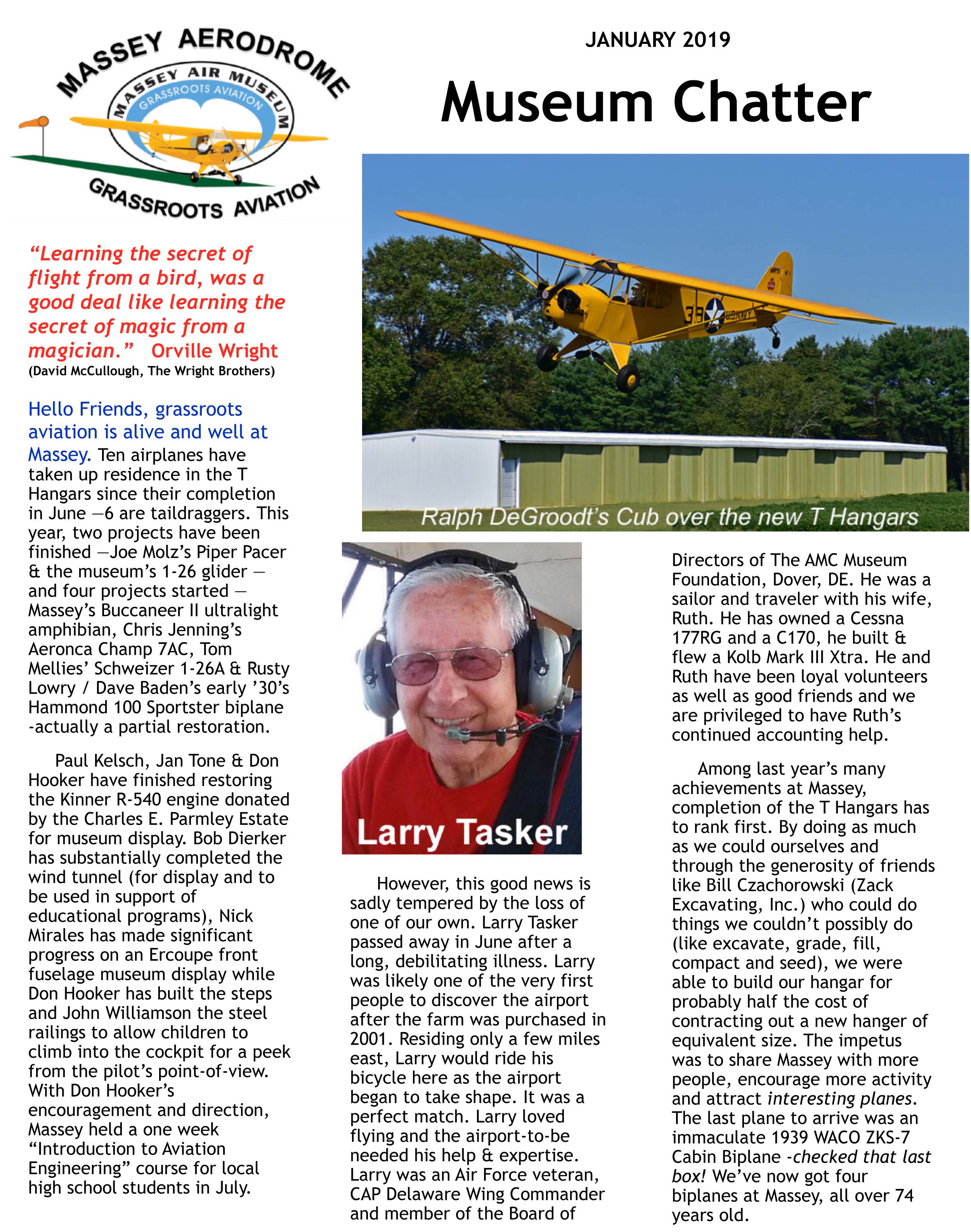
Page One

Page Two
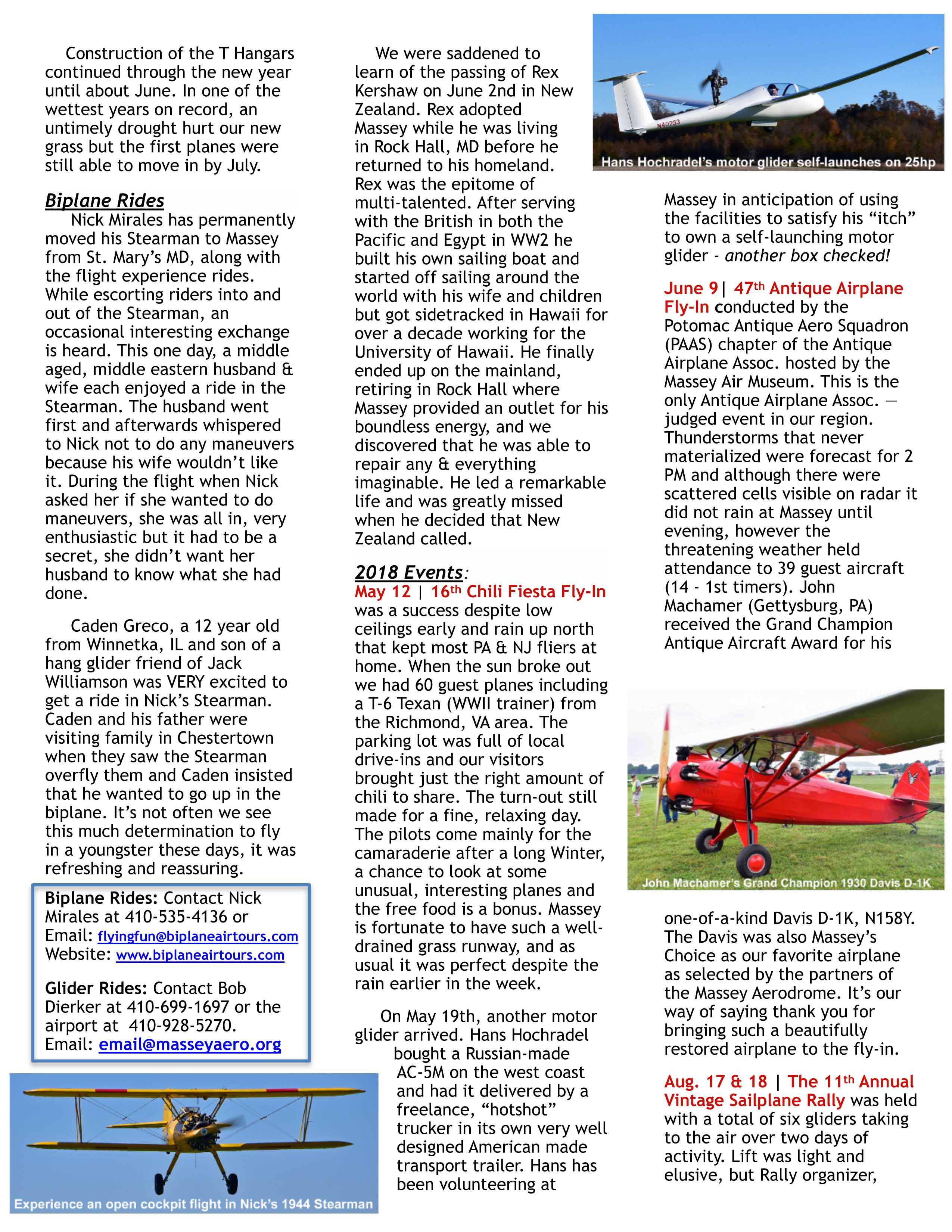
Page Three
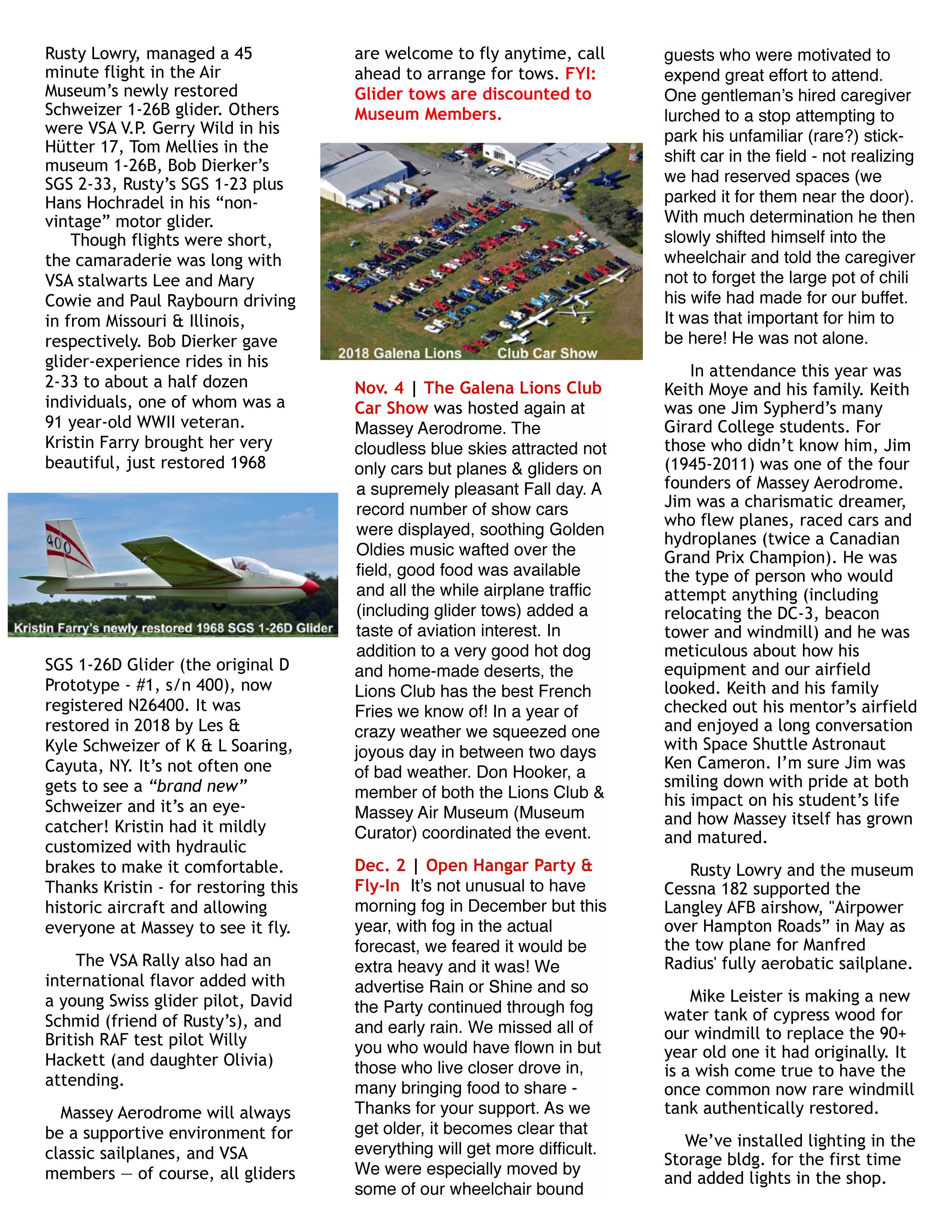
Page Four
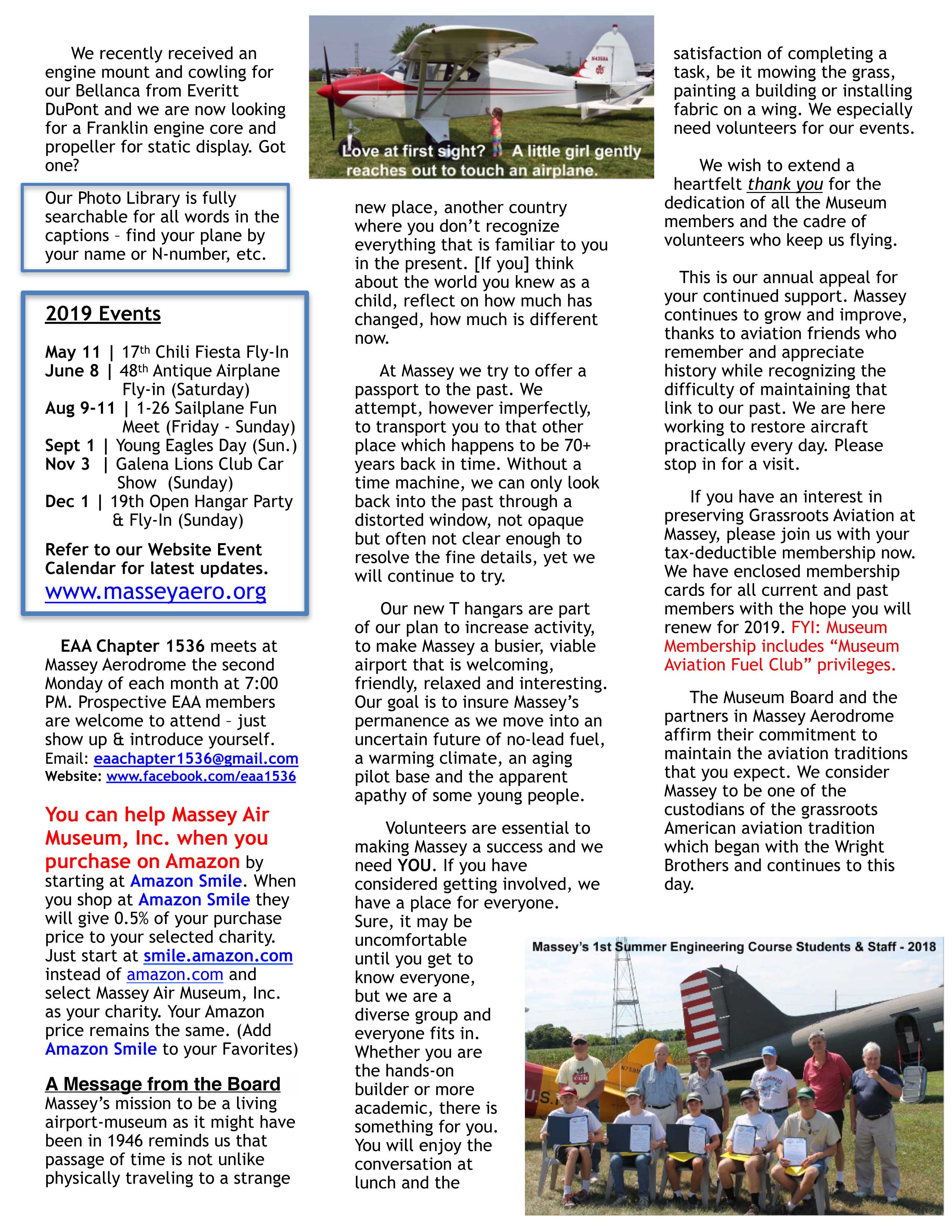
Page Five
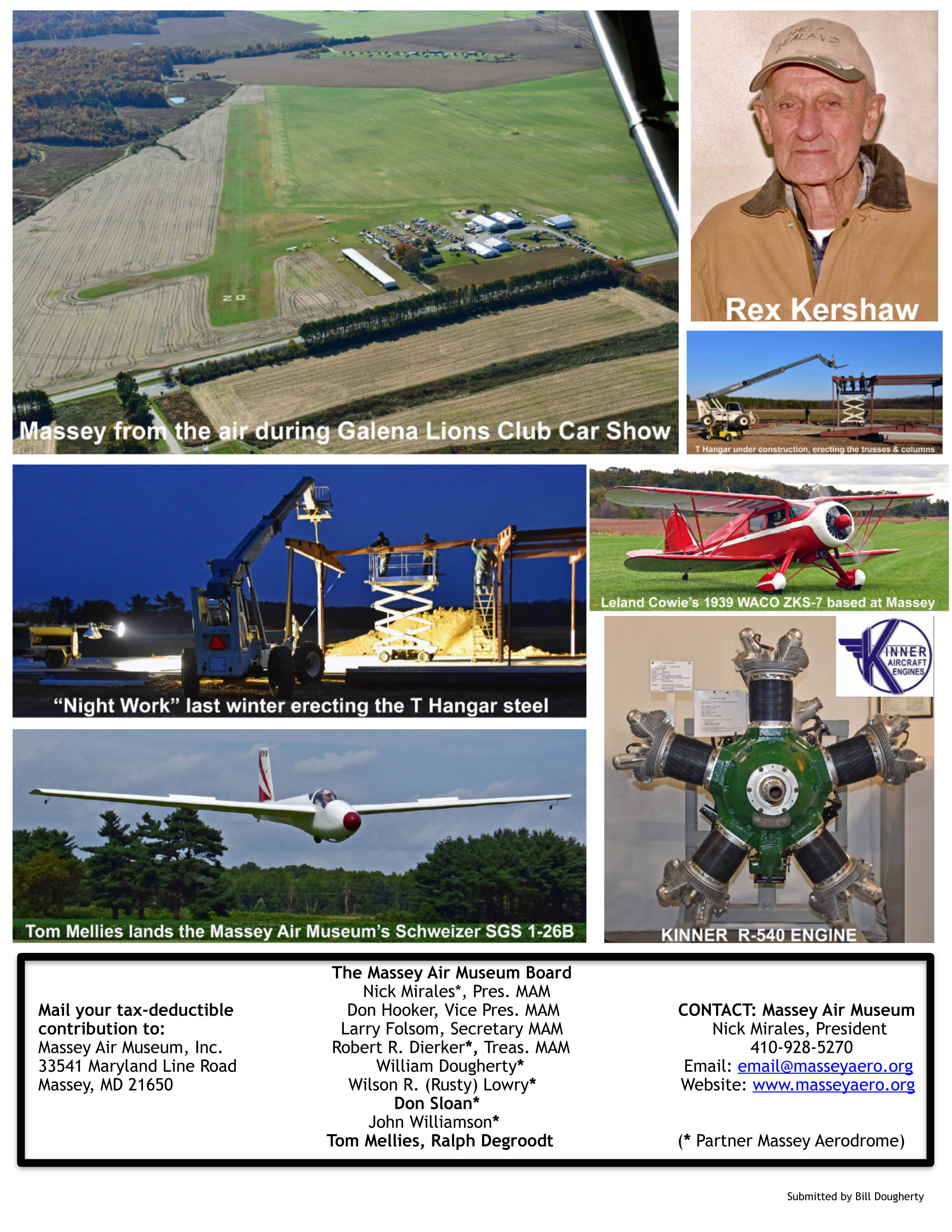
Page Six
2018 Vintage Sailplane Rally at Massey
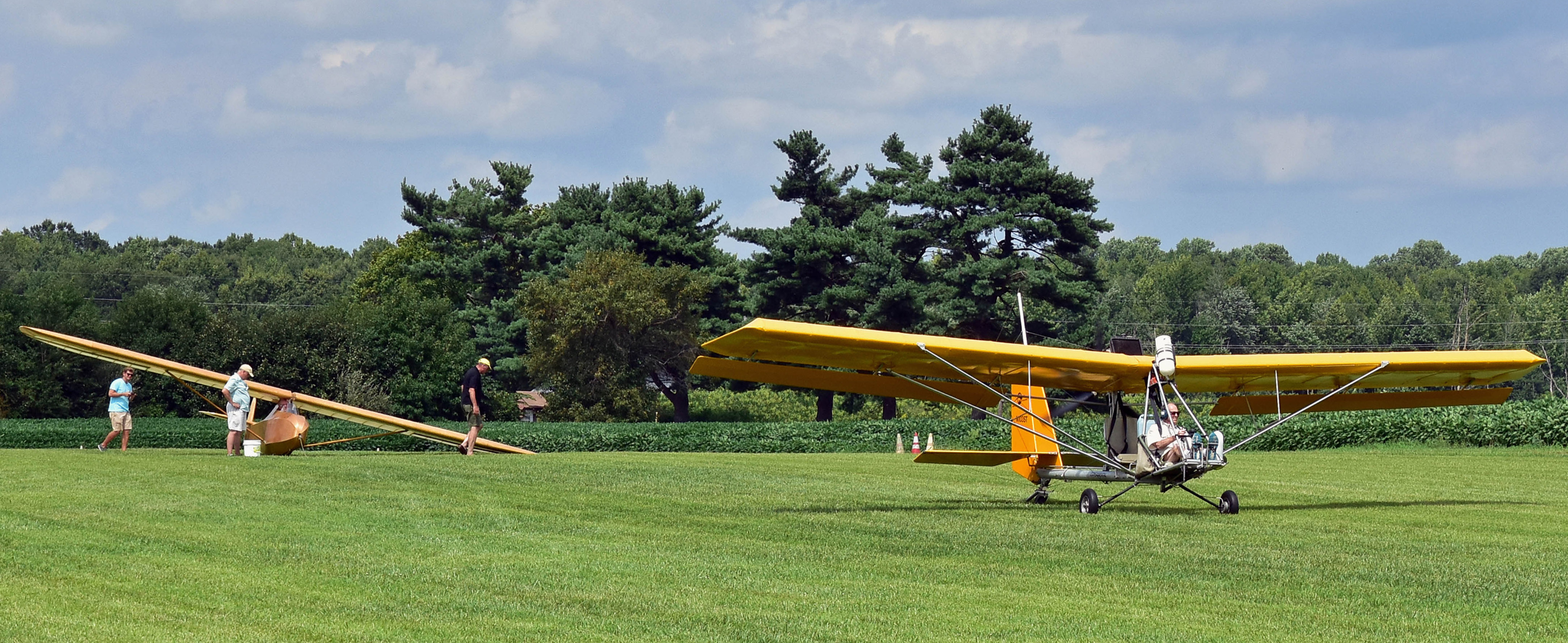
The Vintage Sailplane Rally enjoyed good weather for 2 of the 3 scheduled days (Aug. 17-19, 2018). We could have asked for more lift but considering the thunderstorms forecast (and around us) we were extremely fortunate to have sunshine on Friday & Saturday. Bob Dierker gave glider experience rides in his 2-33 to about a half dozen individuals, one of whom was a 91 year old veteran. Gerry Wild brought his unique Hütter 17 and Hans Hochradel flew is newly acquired Aviastroitel AC-5M Motor-Glider.

VSA regular, Kristin Farry brought her very beautiful, just restored 1968 SGS 1-26D Glider (the original #1 – D Prototype, s/n 400), now registered N26400. Restored in 2018 by K & L Soaring, Les & Kyle Schweizer of Cayuta, NY.
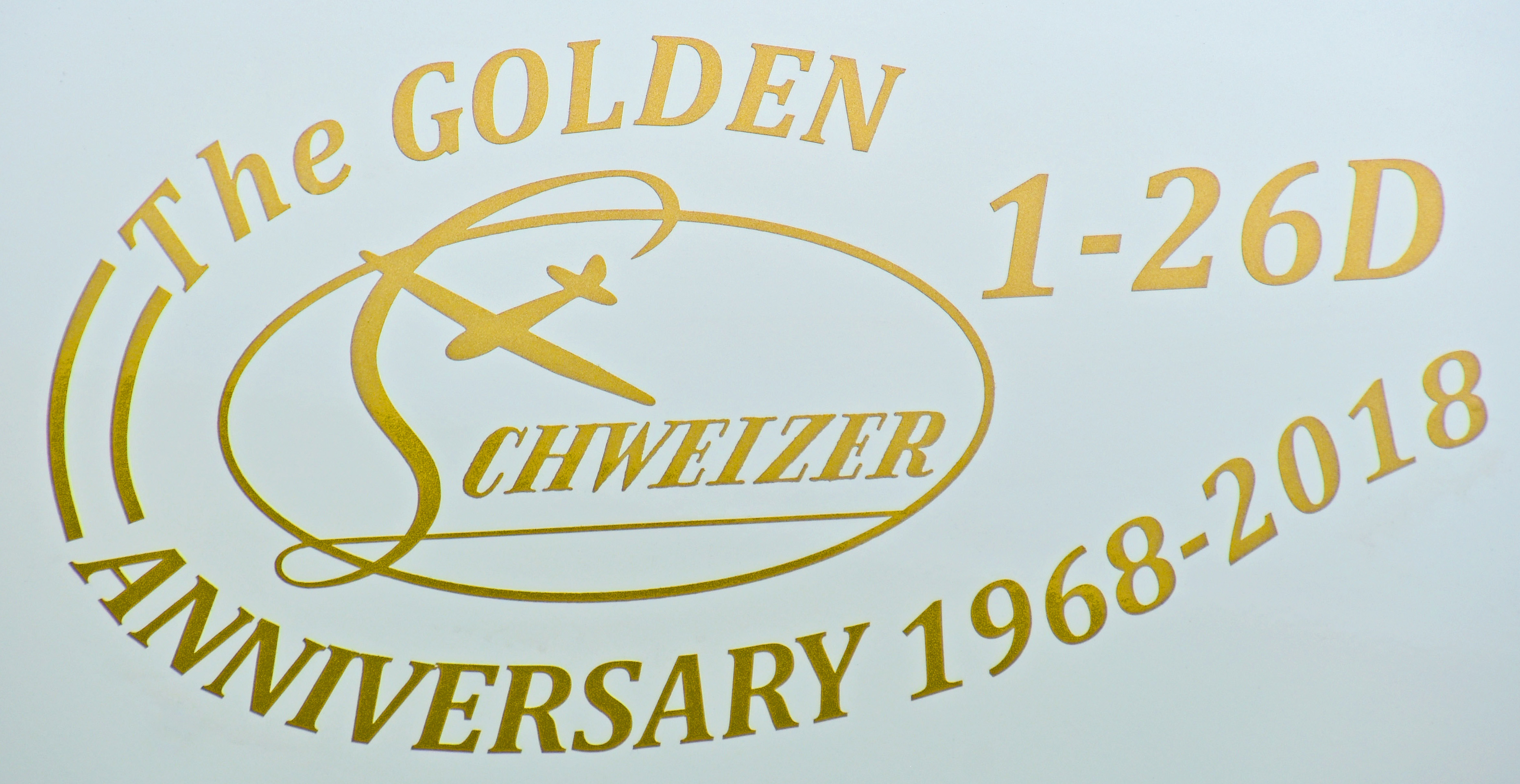
It’s not often one gets to see a “brand new” Schweizer and it’s an eye-catcher! Kristin had it mildly customized with hydraulic brakes and ??? to make it comfortable. Thanks Kristin – for restoring this historic aircraft and allowing everyone at Massey to see it fly.
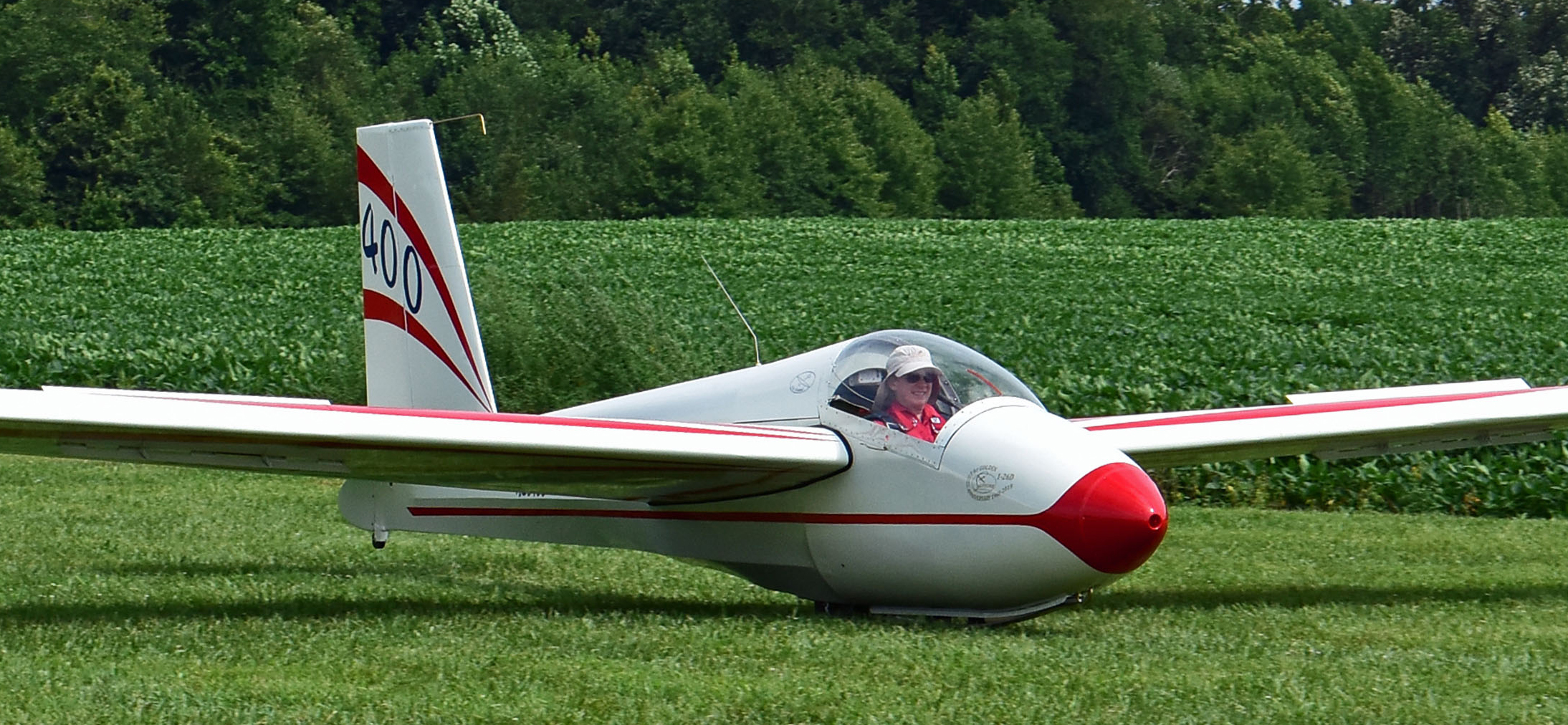
Hans Hochradel, Annapolis, MD, got a tow from Rusty with the Massey C-182 but did not deploy the motor, grass is probably not conducive to self launching but should be useful for sustainment. The Aviastroitel is a Russian mid-wing, single seat, T-tailed motor glider (and unmanned aerial vehicle) that was produced by Aviastroitel, now Glider Air Craft. Engine is a 25 hp Zanzottera MZ-35R with 2-bladed retractable propellers. Wingspan: 41’ – 4”, Length: 17’ – 5”, Gross weight: 661 lb., Glide ratio: 35:1.

Tom Mellies flew the Massey Air Museum’s 1968 Schweizer SGS 1-26B, N5777S, s/n #393 that he helped to restore. It’s satisfying when all your work pays off with a good flying machine. We have a 1-26 open “sport canopy” that Tom is anxious to try out on it.
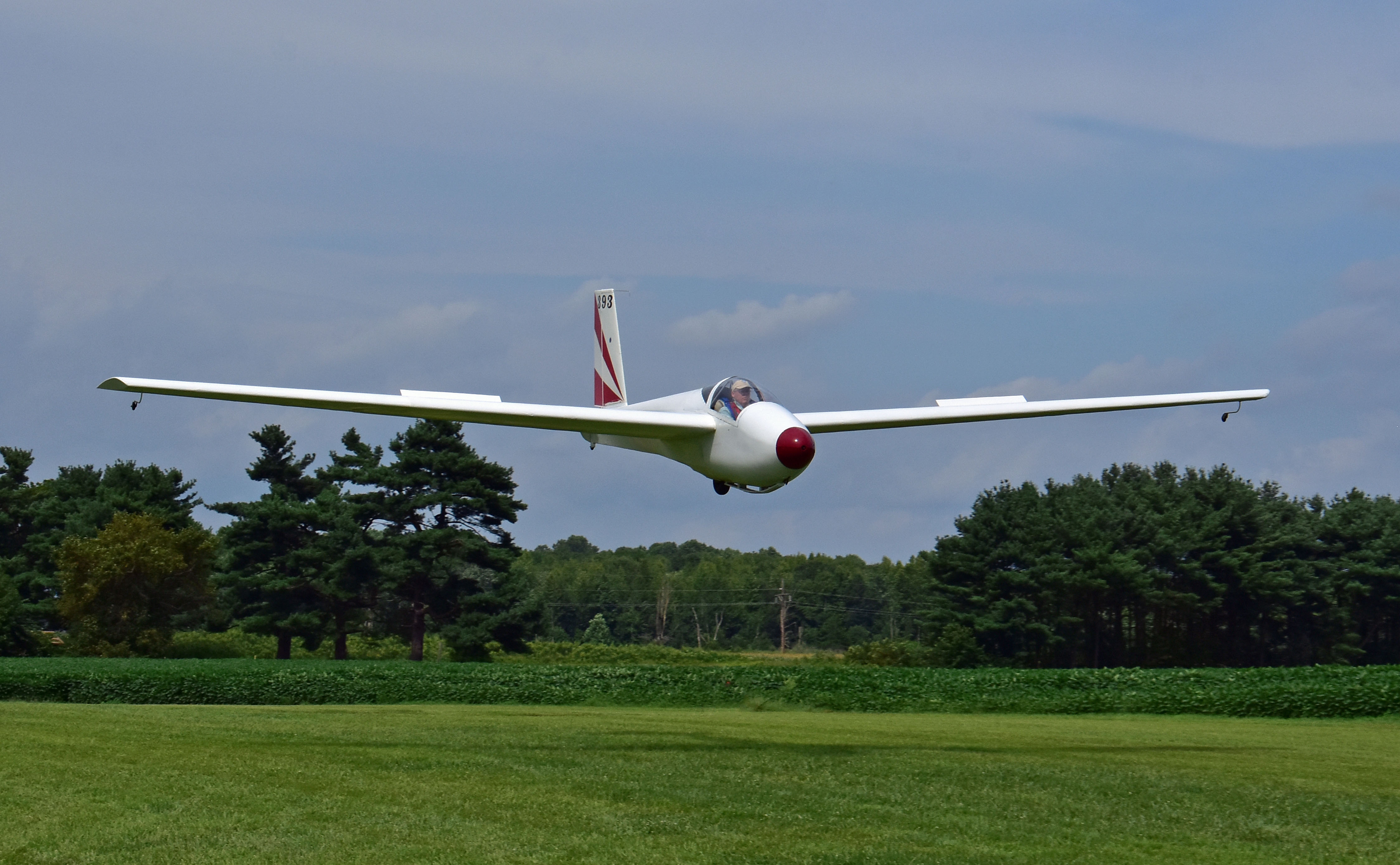
We tow Gerry Wild’s 1990 Hütter 17 (N17HU) with John Williamson’s Moyes Dragonfly (hang glider tug) because the 182 is really too fast. We’ve learned that a little soapy water on the grass helps to release the skid (no wheel), then the Dragonfly is the perfect tow plane. The Hütter is a 1934 Austrian design. Specifications: 143 lb. Empty wt., 348 lb. Gross Wt., 31.8’ Wing Span.
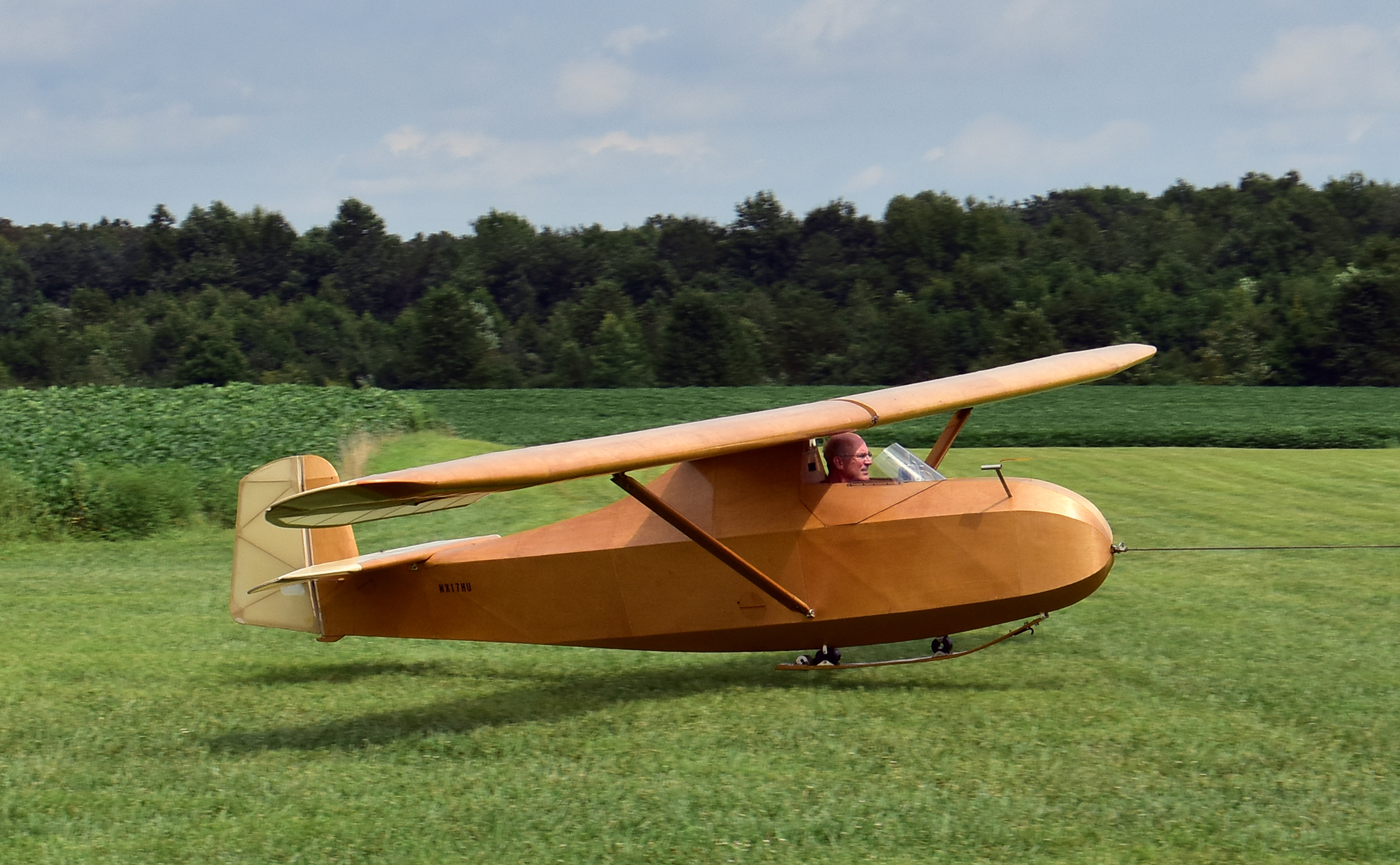
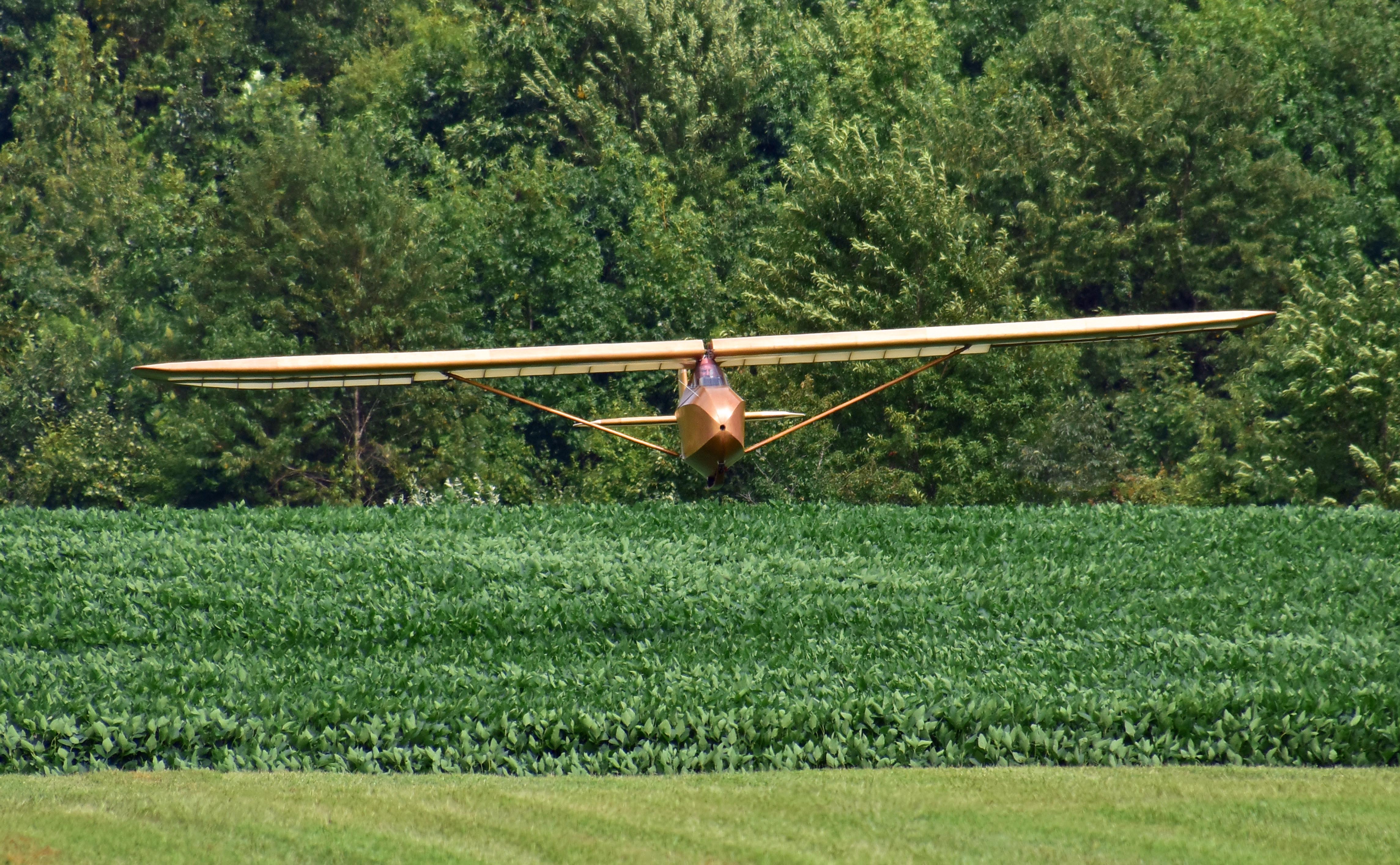
Gp. Capt. “Willy” Hackett, RAF, had been living in Arlington, VA, while posted to the UK’s F-35 Joint Program Office at PAX River when he discovered Massey’s Glider Rally three years ago and hasn’t missed it since. This year he brought his daughter, nine year old Olivia, who really enjoyed the day at the airport – and we enjoyed her company.
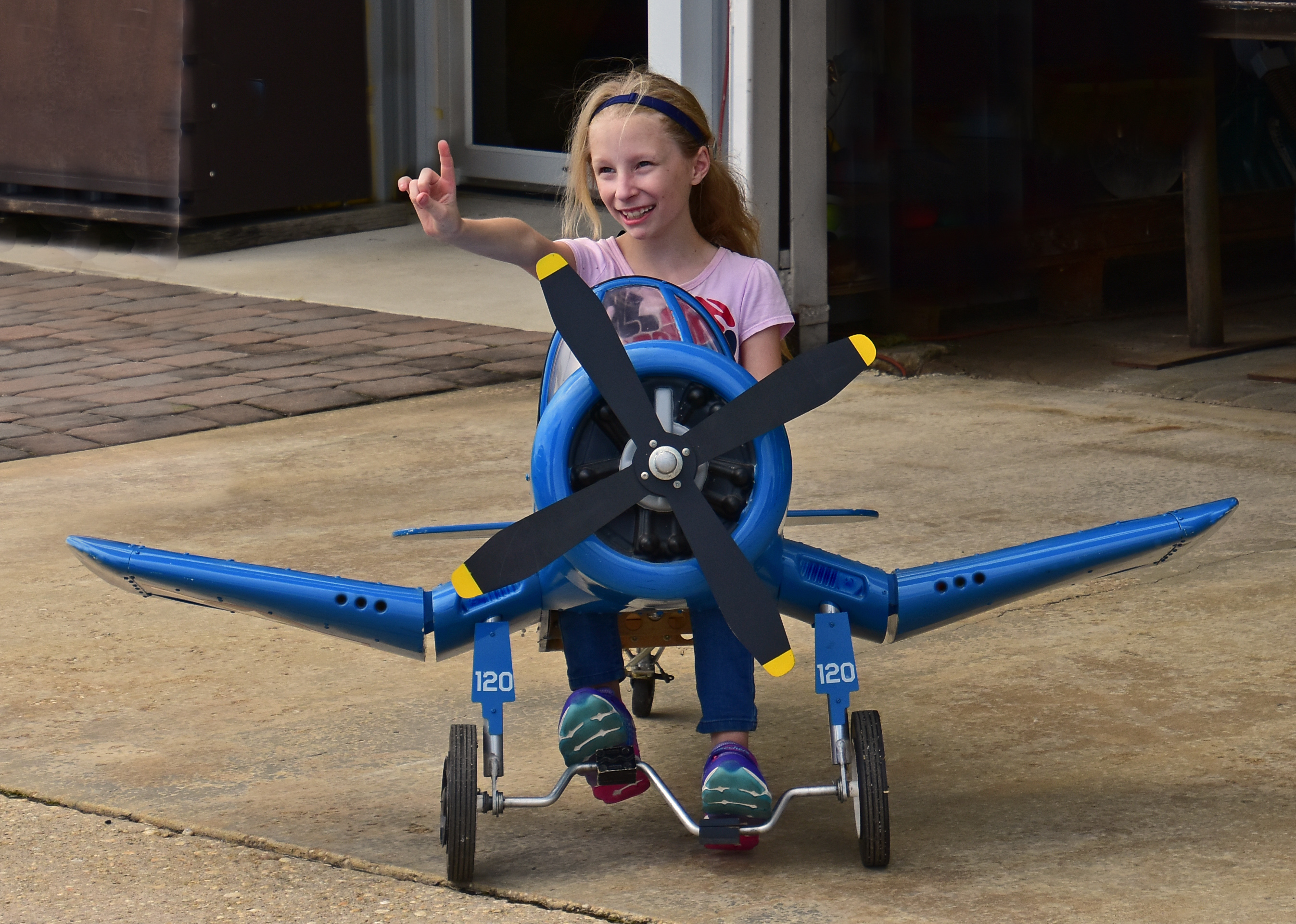
While nominally a Vintage Sailplane event, in actuality gliders of any age are invited, this is a relaxed opportunity to fly your glider and spend time with like-minded persons. Massey is open to all!
2018 Antique Airplane Fly-In
The 50th Anniversary & 47th Antique Airplane Fly-In held on June 9th, 2018, conducted by the Potomac Antique Aero Squadron (PAAS) chapter of the Antique Airplane Assoc. Hosted by Massey Aerodrome MD1. This is the only Antique Airplane Assoc. Judged event in our region (Formerly the Horn Point Fly-In). Thunderstorms were forecast for 2 PM and although there were scattered cells visible on radar around us, it did not rain at Massey until evening. The threatening weather held attendance to 39 guest aircraft (14 1st timers).
Retiring PAAS Fly-In Director, Mike Streiter, welcomed Gretta Thorwarth as the new Fly-In Director for 2019.
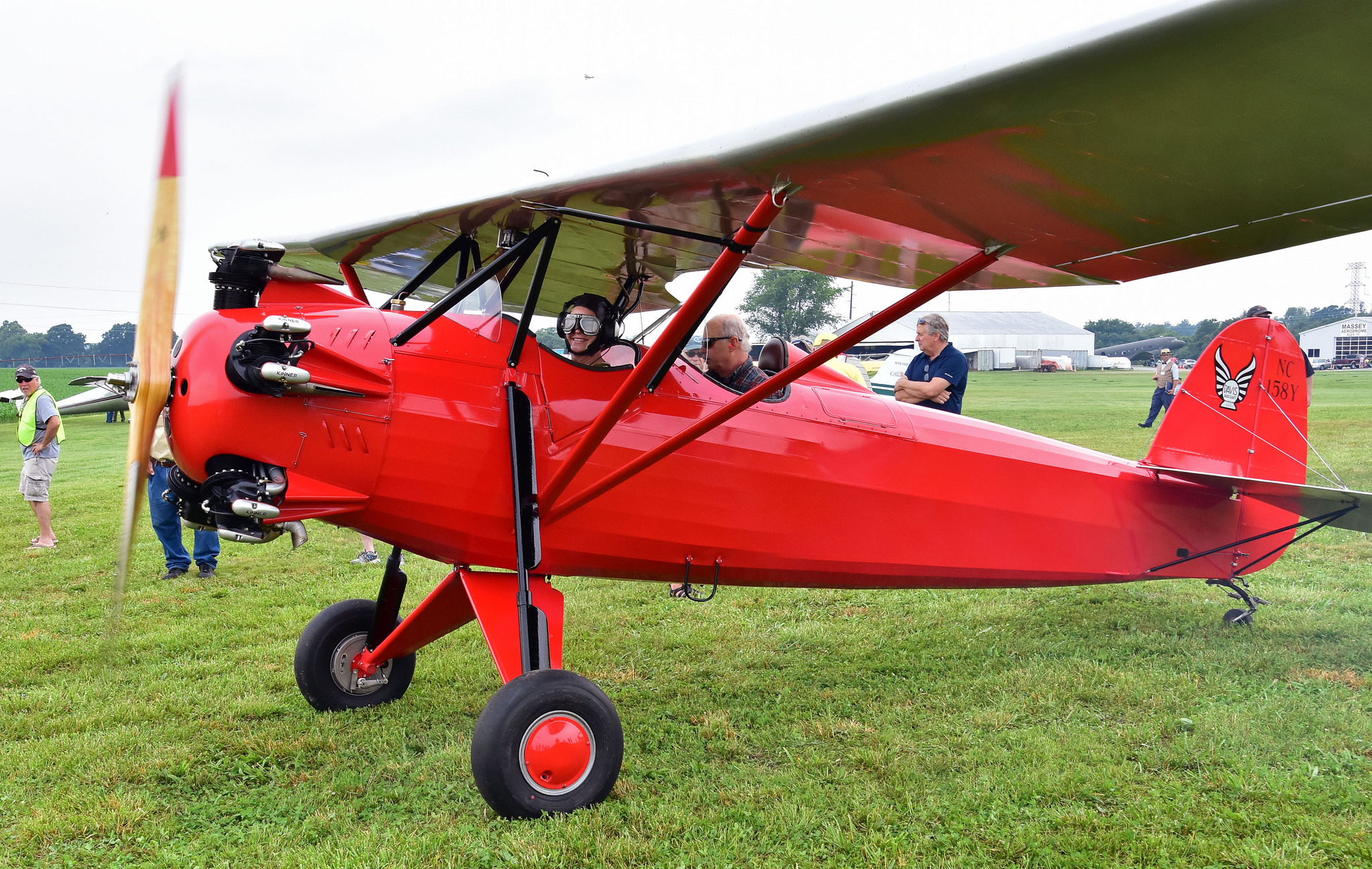 John Machamer of Gettysburg, PA received a bottle of Chandelle Winery Sonoma Sauvignon Blanc as the 2018 Massey “Choice” Award for his one of a kind 1930 DAVIS D-1K as well as the Grand Champion Antique Aircraft Award.
John Machamer of Gettysburg, PA received a bottle of Chandelle Winery Sonoma Sauvignon Blanc as the 2018 Massey “Choice” Award for his one of a kind 1930 DAVIS D-1K as well as the Grand Champion Antique Aircraft Award.
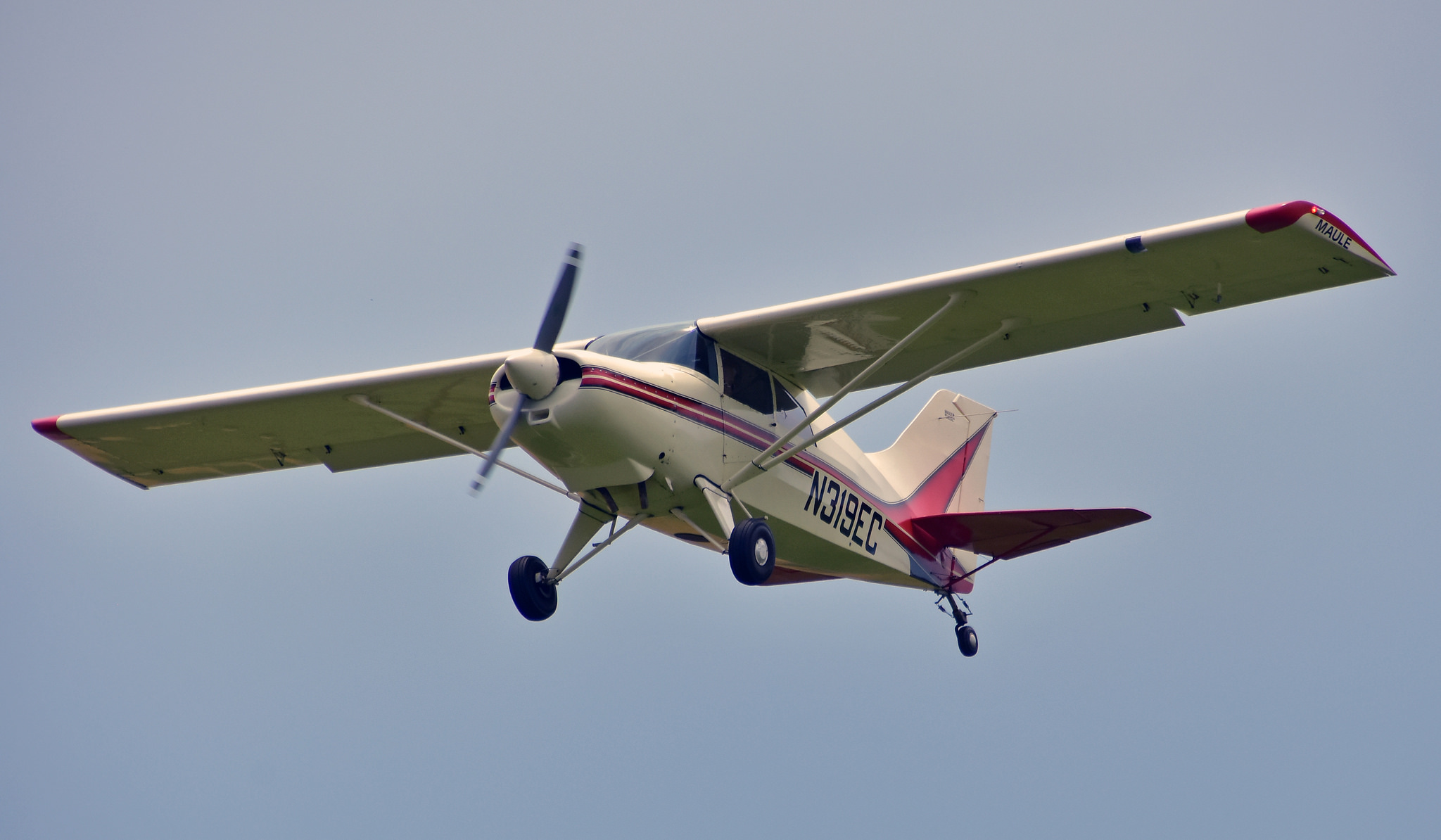
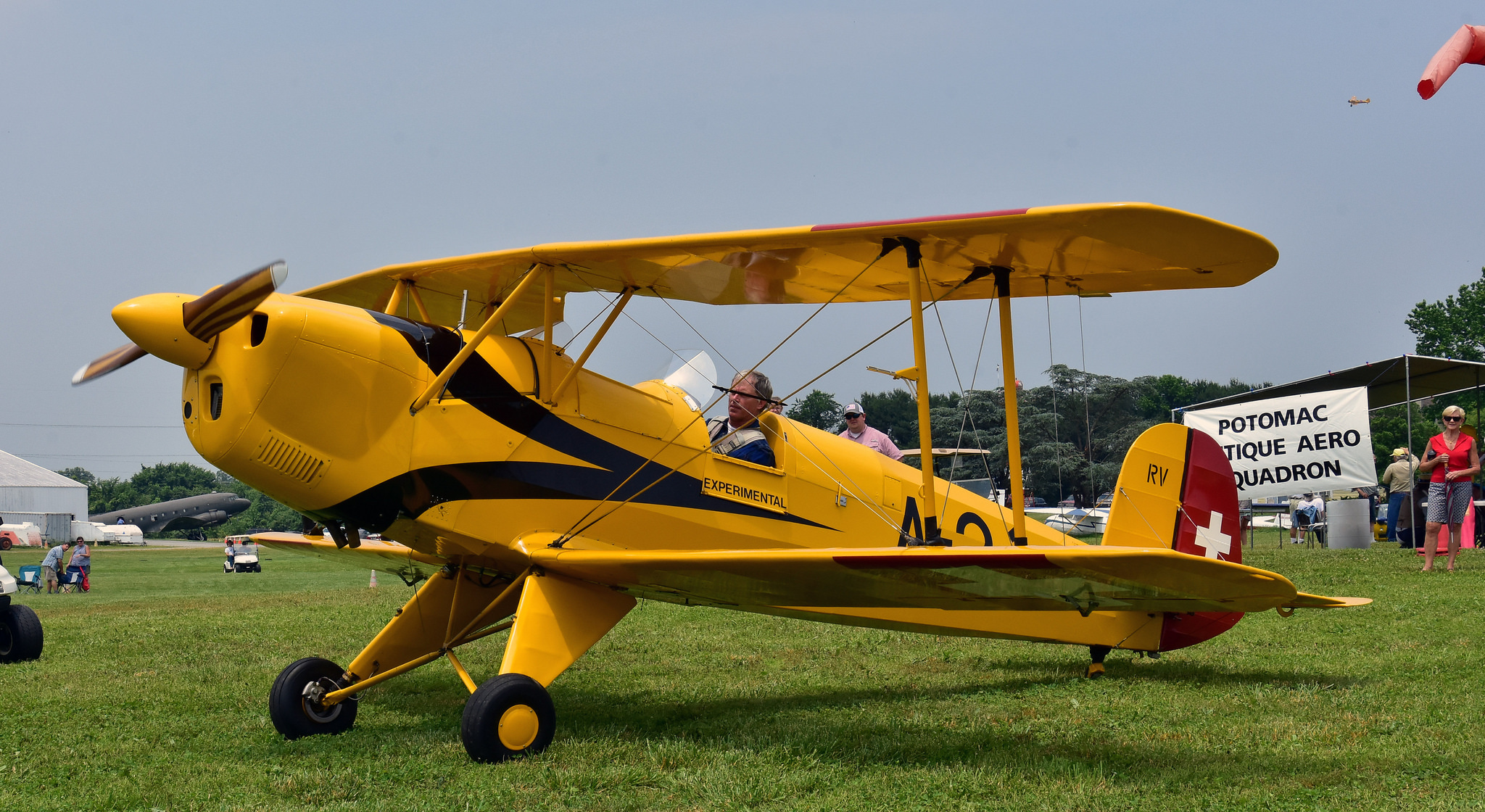
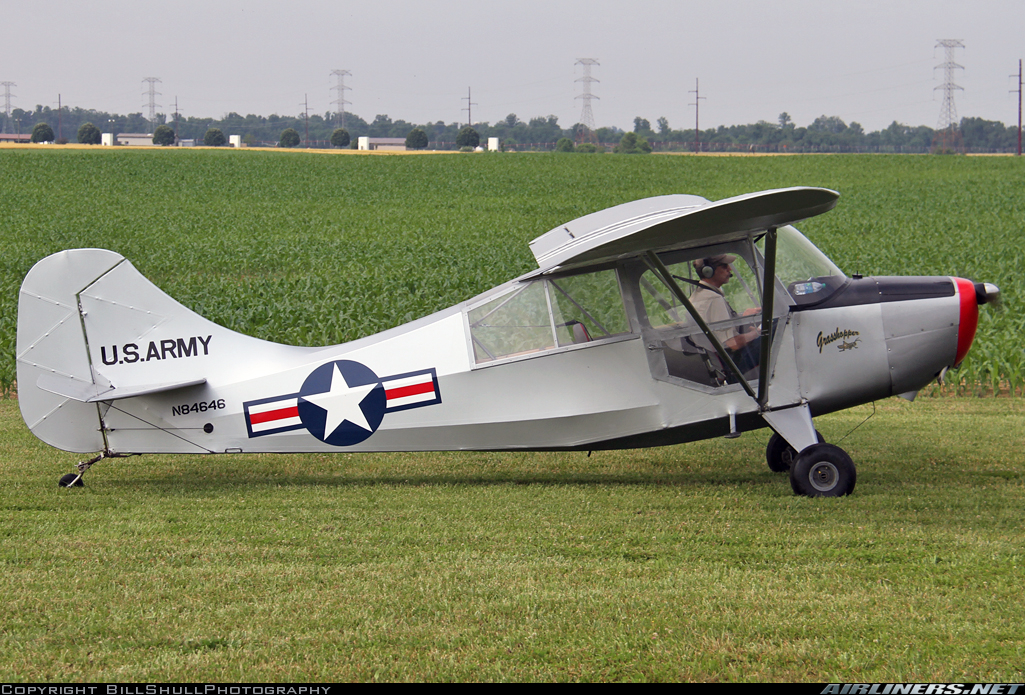
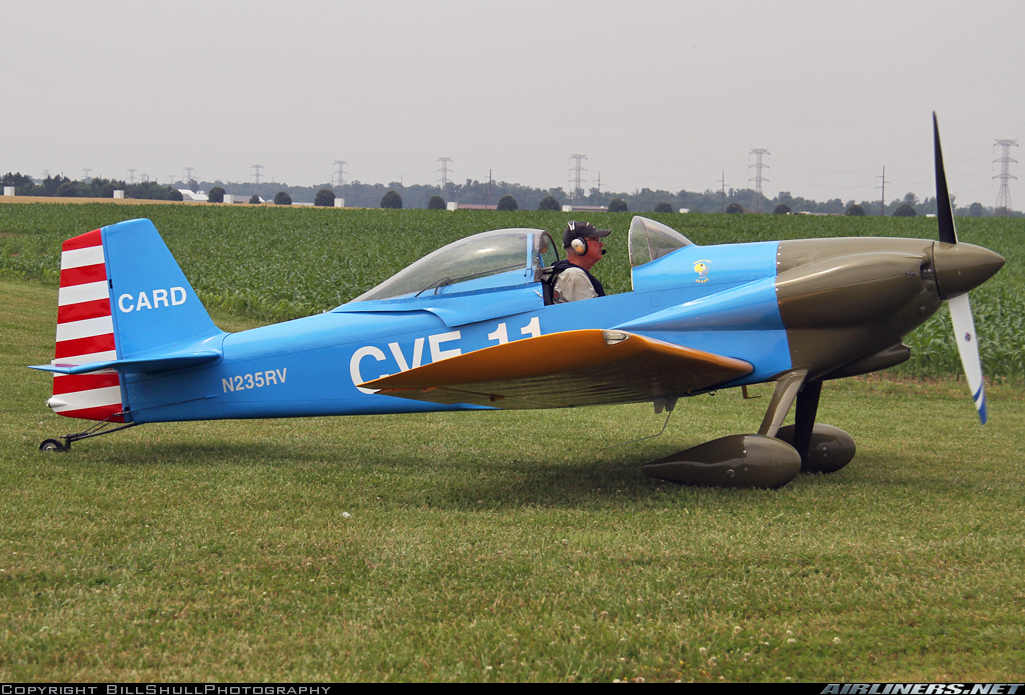
2018 Awards:
Grand Champion Antique Aircraft Award: N158Y Davis D-1K , John Machamer, Gettysburg, PA.
Sweepstakes Antique Aircraft Ward: N28621, Luscombe 8C, Mark Webb Delmar, MD.
Grand Champion Classic Award: N2224M, Piper J3C-65, John Lewis, Mickleton, NJ.
Sweepstakes Classic Aircraft: N2168C, Cessna 195B, Brian McCay, Earlysville, VA.
Grand Champion Contemporary Aircraft: N9218D, Piper Tri-Pacer PA-22-160, Frank Vitellaro, Pennington, NJ.
Best Customized Aircraft Award: N1131J C.A.S.A. 1.131 (Spanish built Bücker 131 Jungmann), Greg Stringer, Egg Harbor Twp. NJ.
Best Custom-Built (experimental) Aircraft Award: N235RV, RV-3, Bruce Barrett, Pasadena, MD.
Potomac Antique Aero Squadron President’s Award: N2168C, Cessna 195B, Brian McCay, Earlysville, VA.
Antique Aircraft Assoc. Club Award: N24739 Piper J3 Cub, Ralph DeGroodt, Galena, MD.

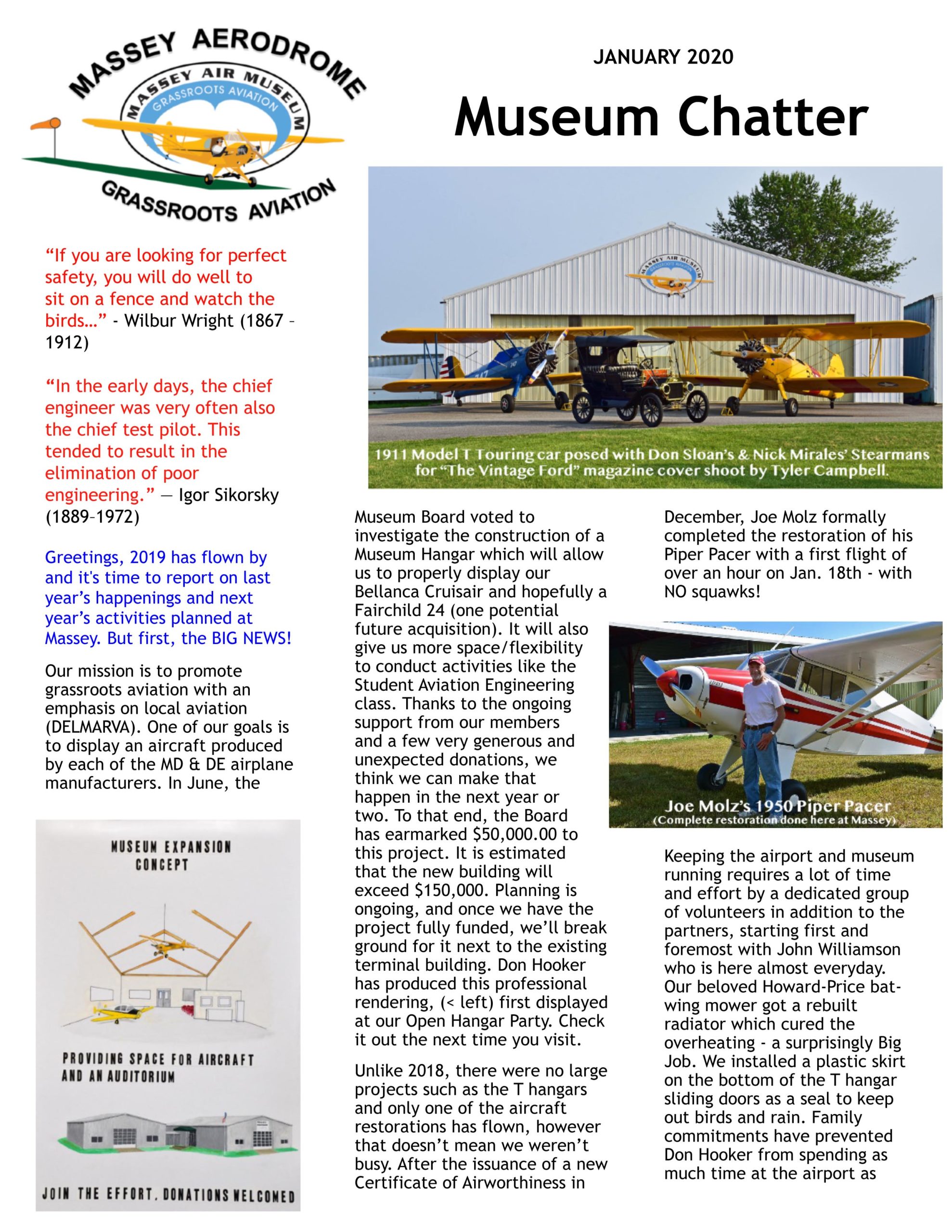 *****2020 Museum Chatter Page 1 PDF
*****2020 Museum Chatter Page 1 PDF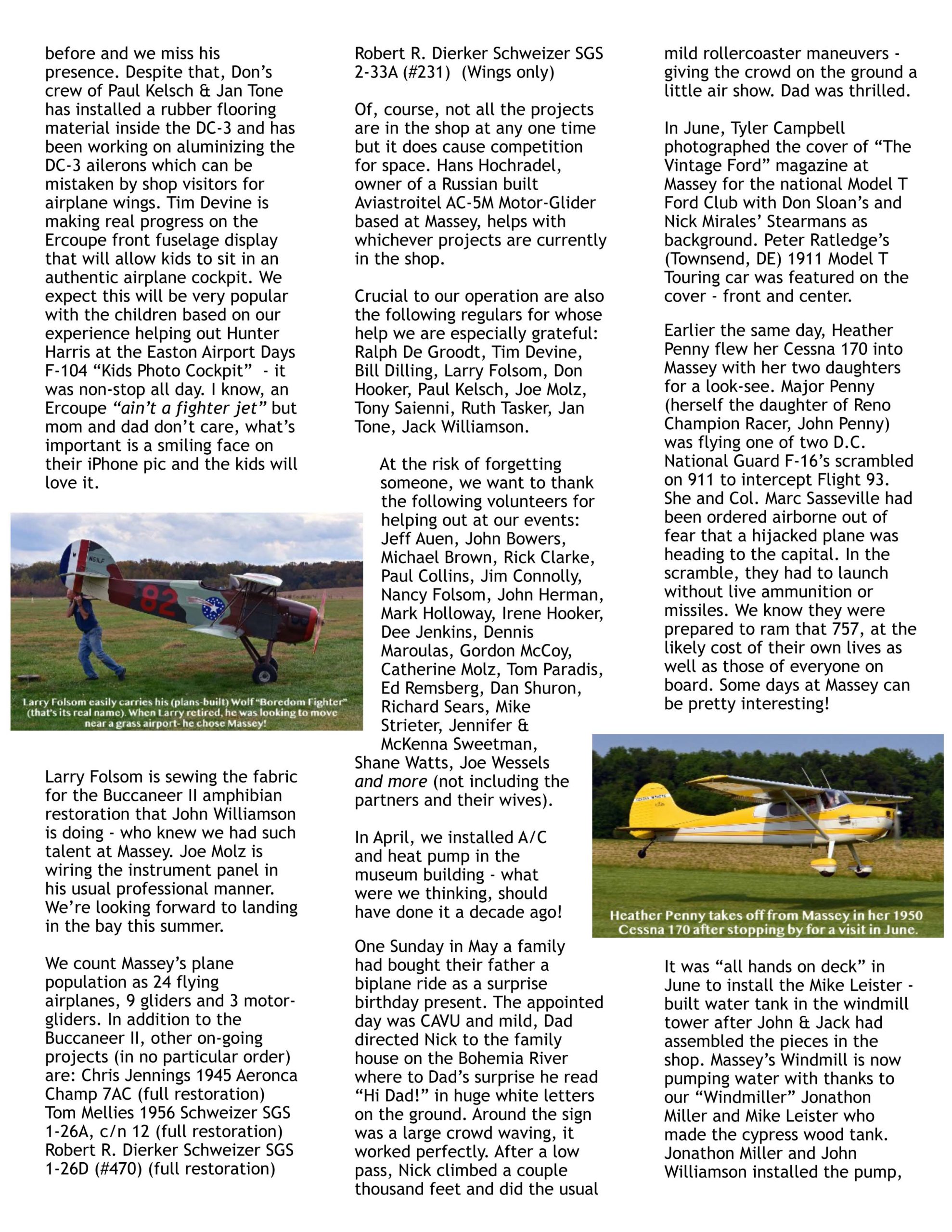 *****2020 Museum Chatter Page 2 PDF
*****2020 Museum Chatter Page 2 PDF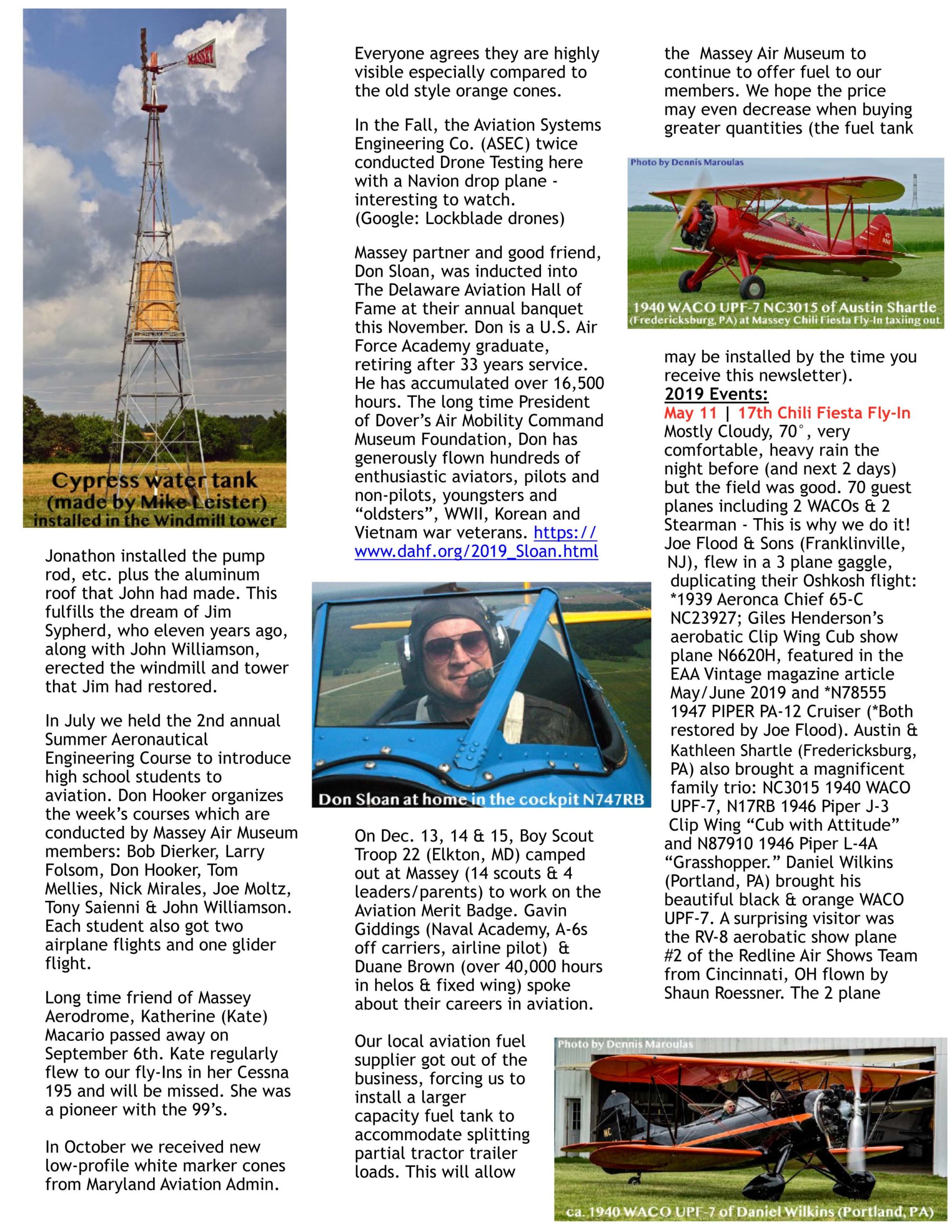
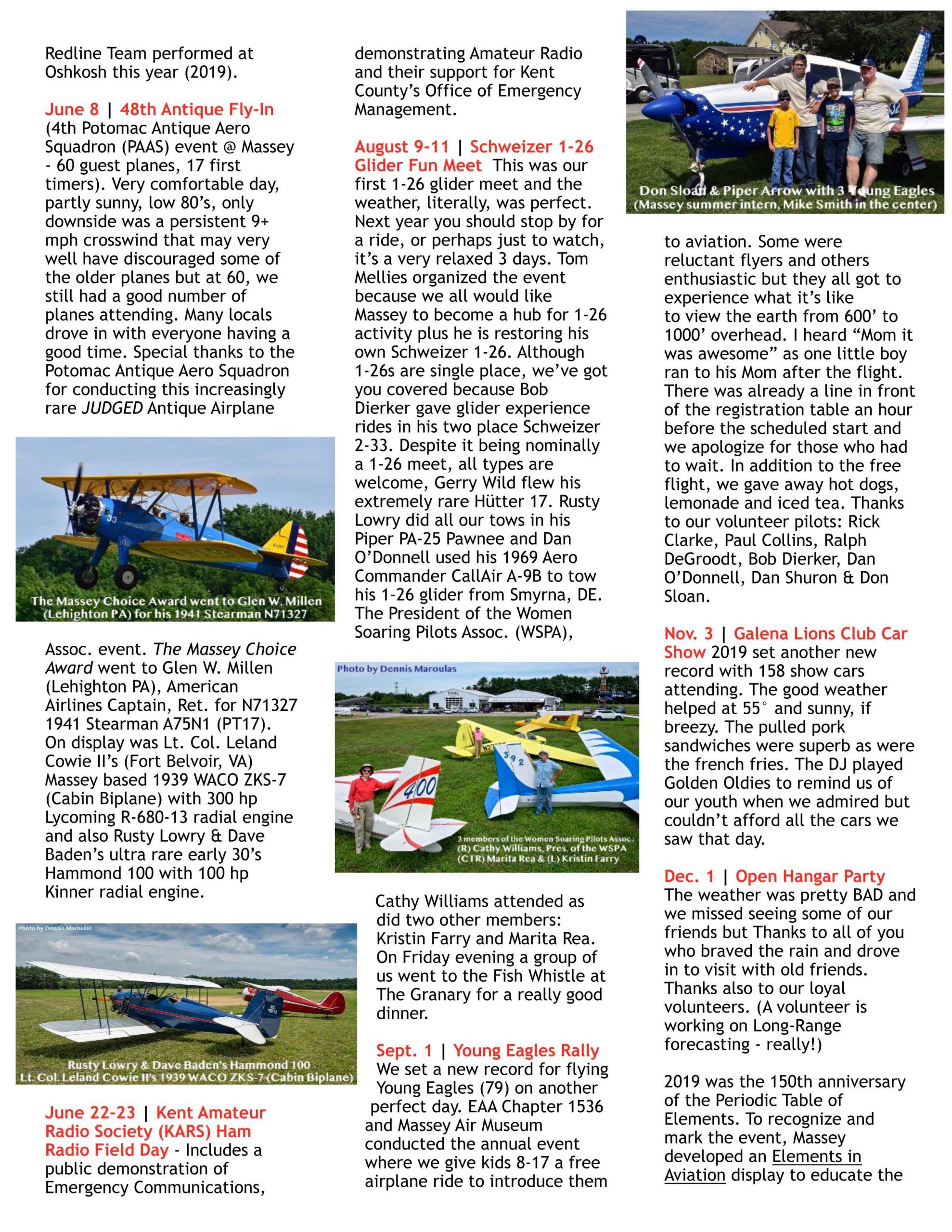
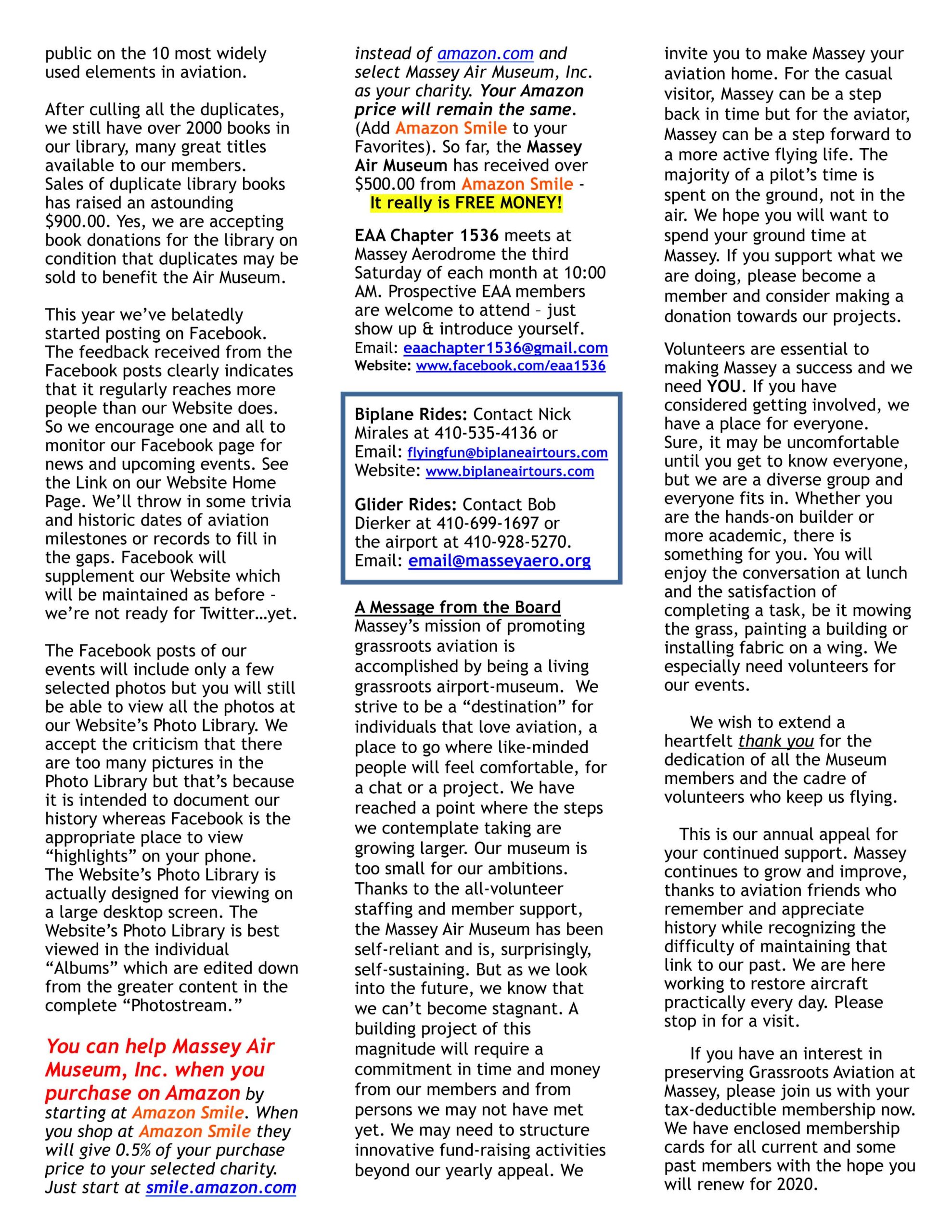
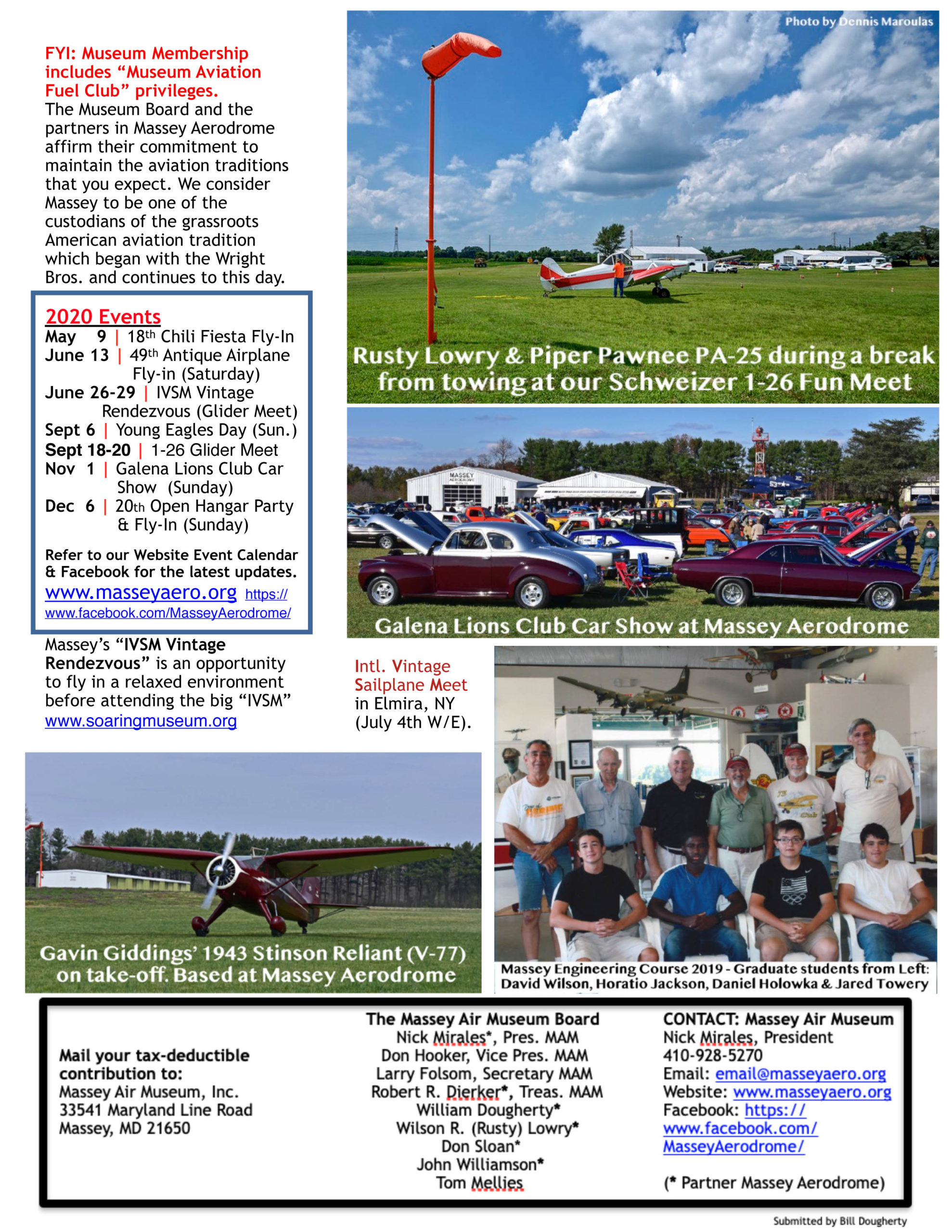 *****2020 Museum Chatter Page 6 PDF
*****2020 Museum Chatter Page 6 PDF
